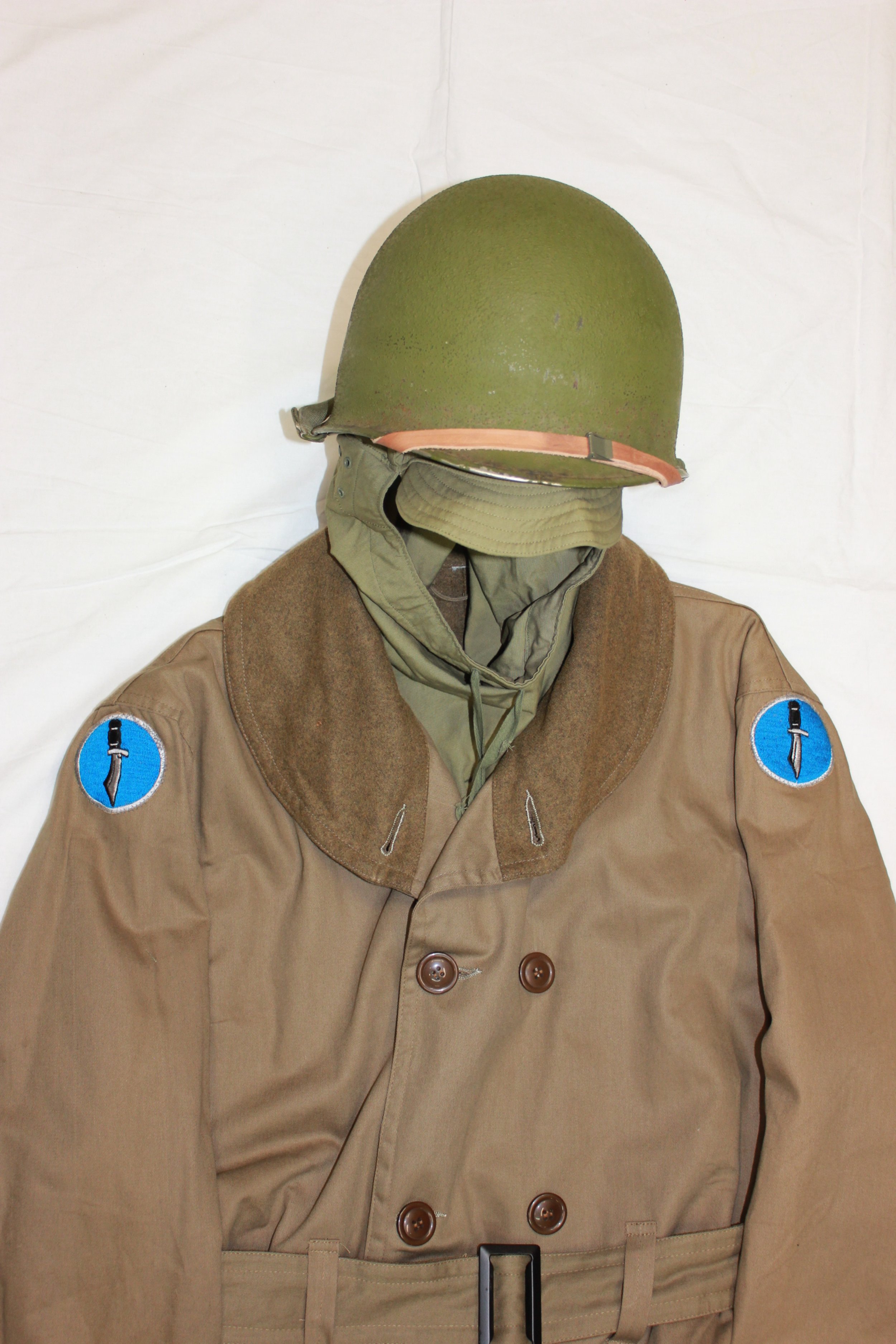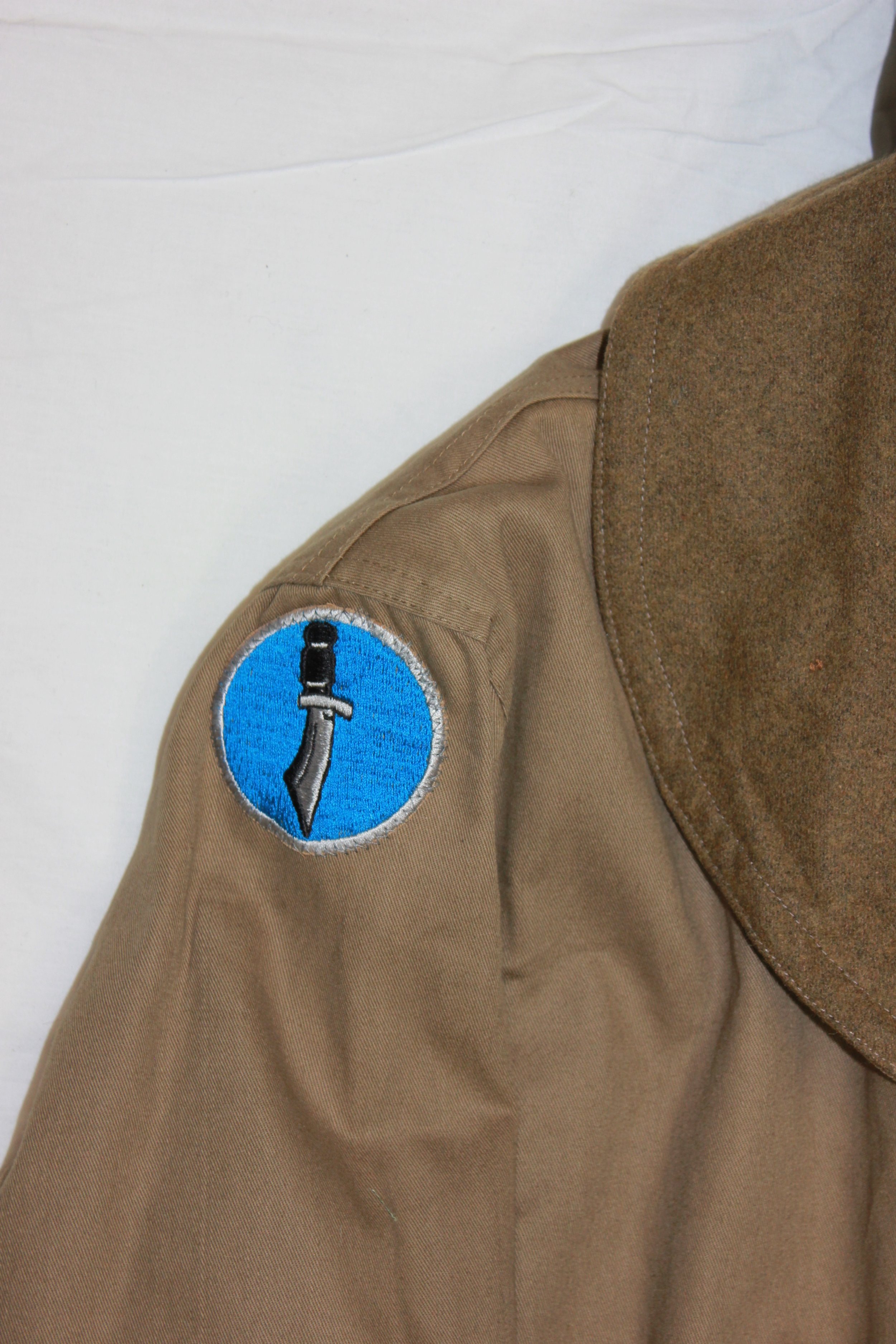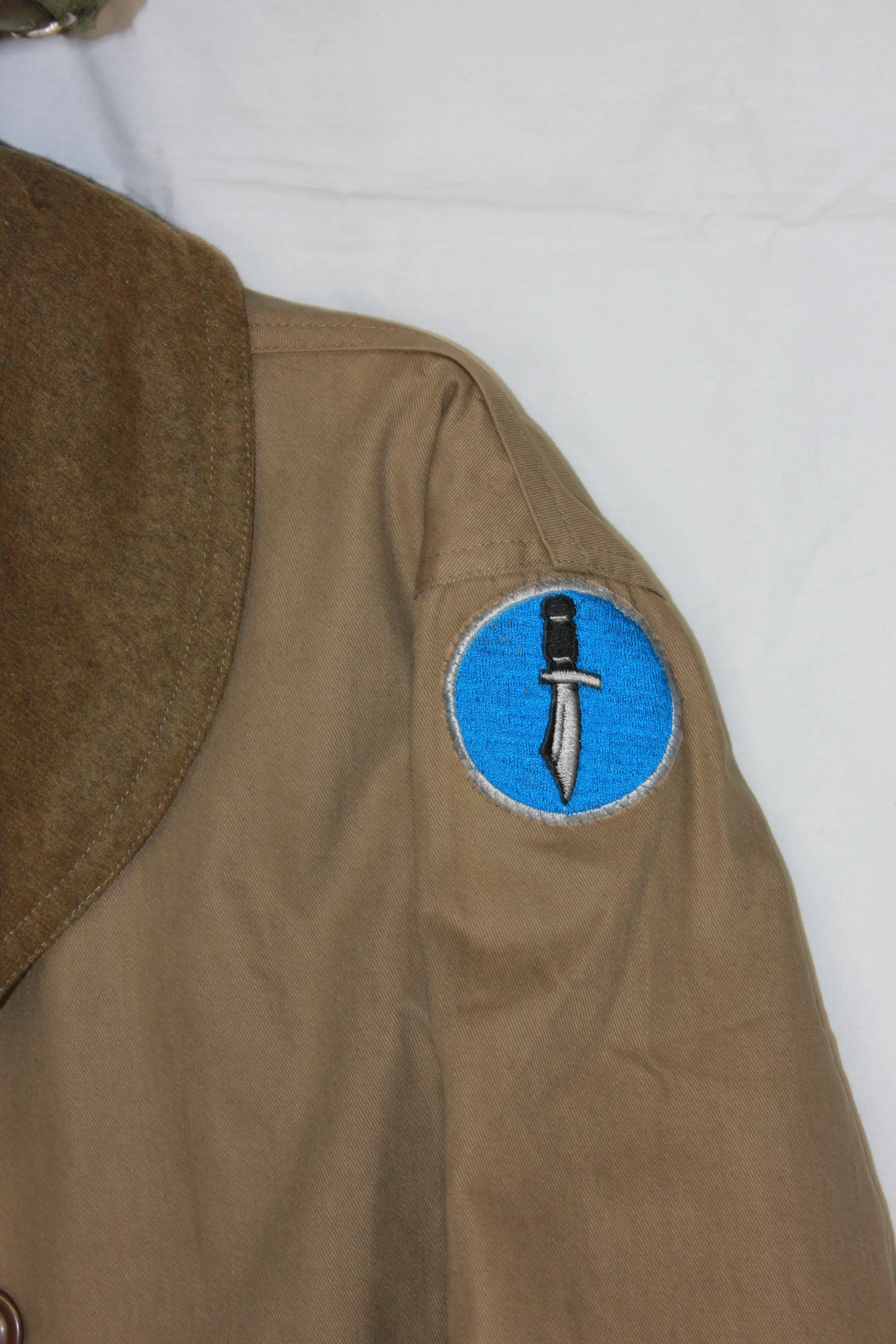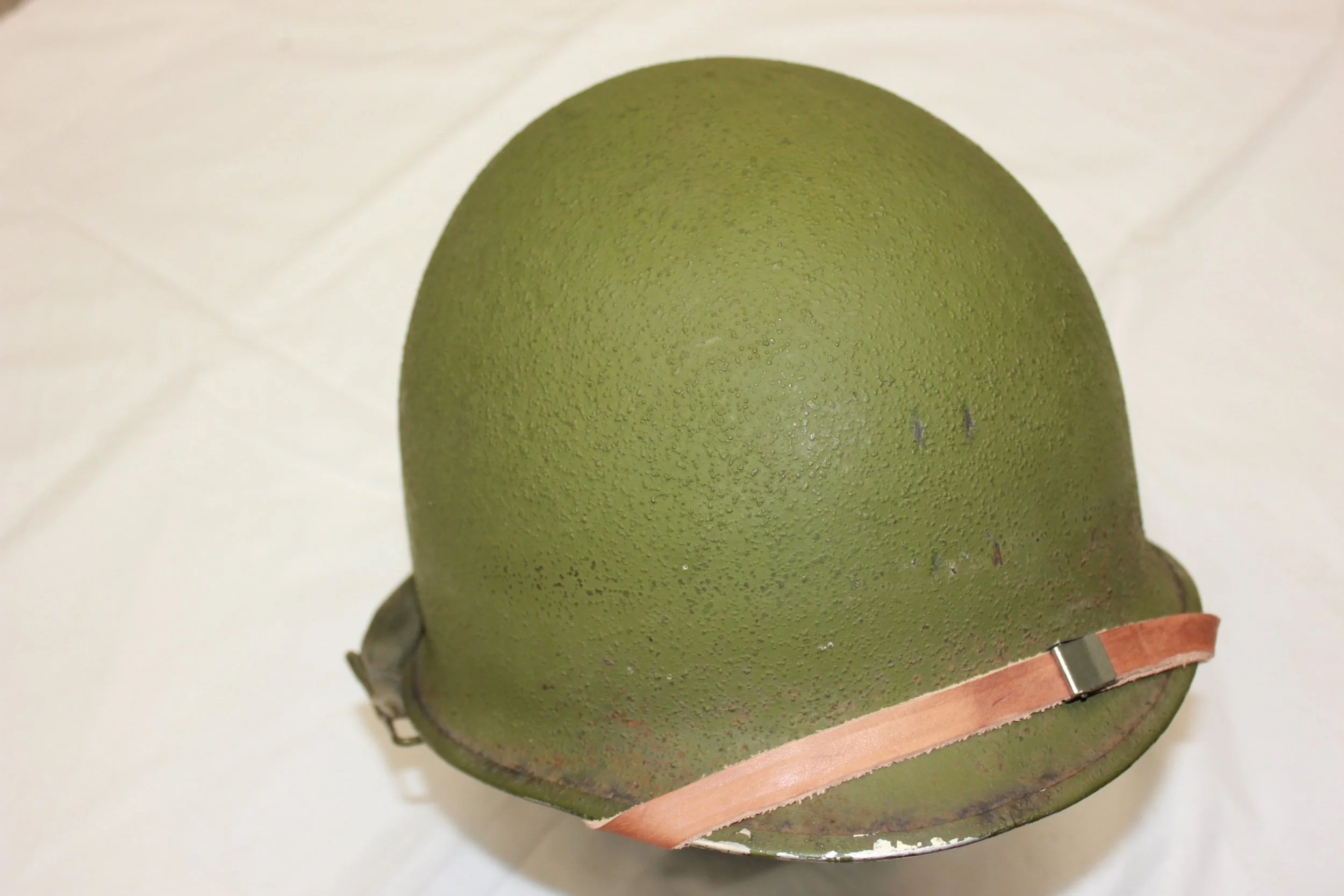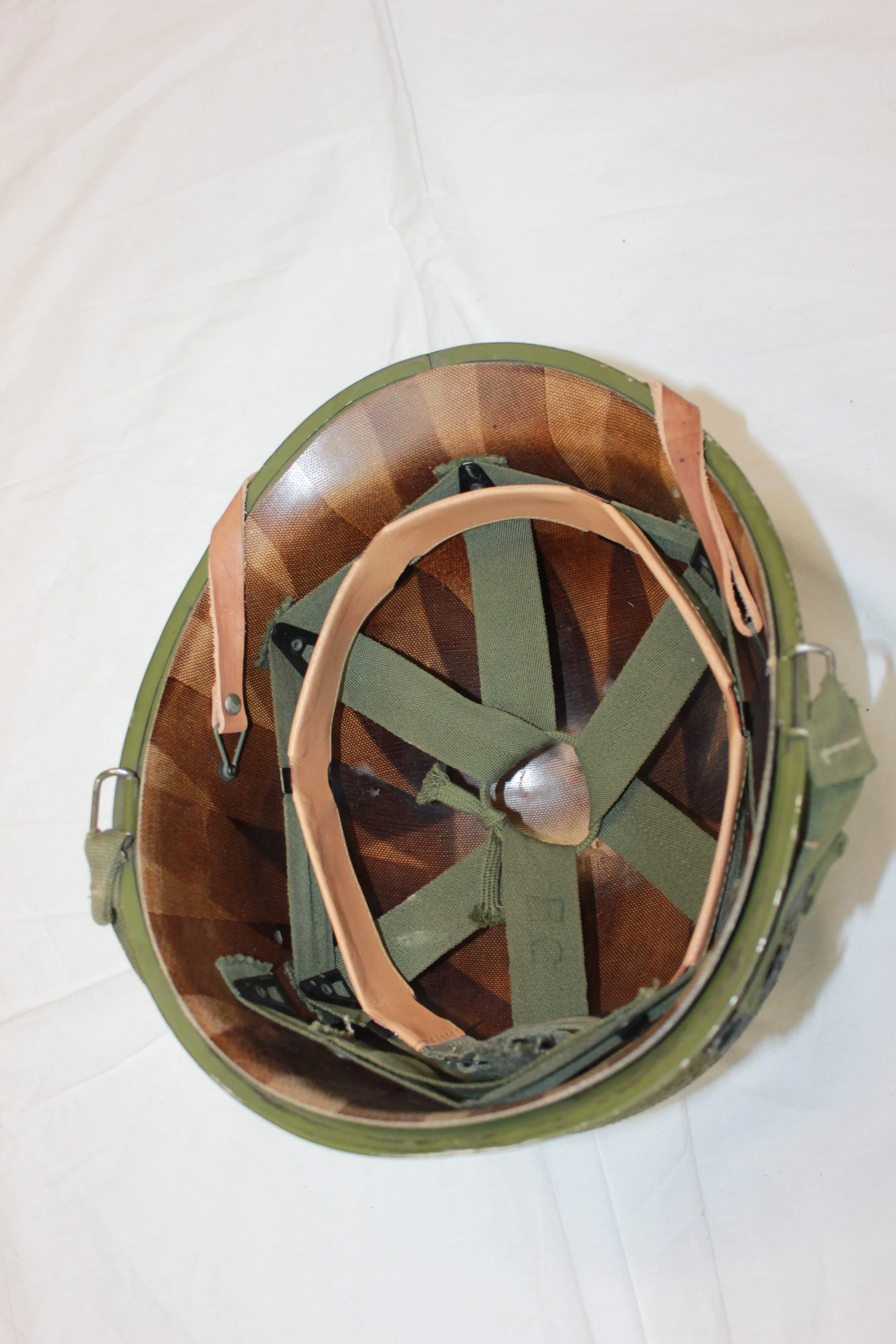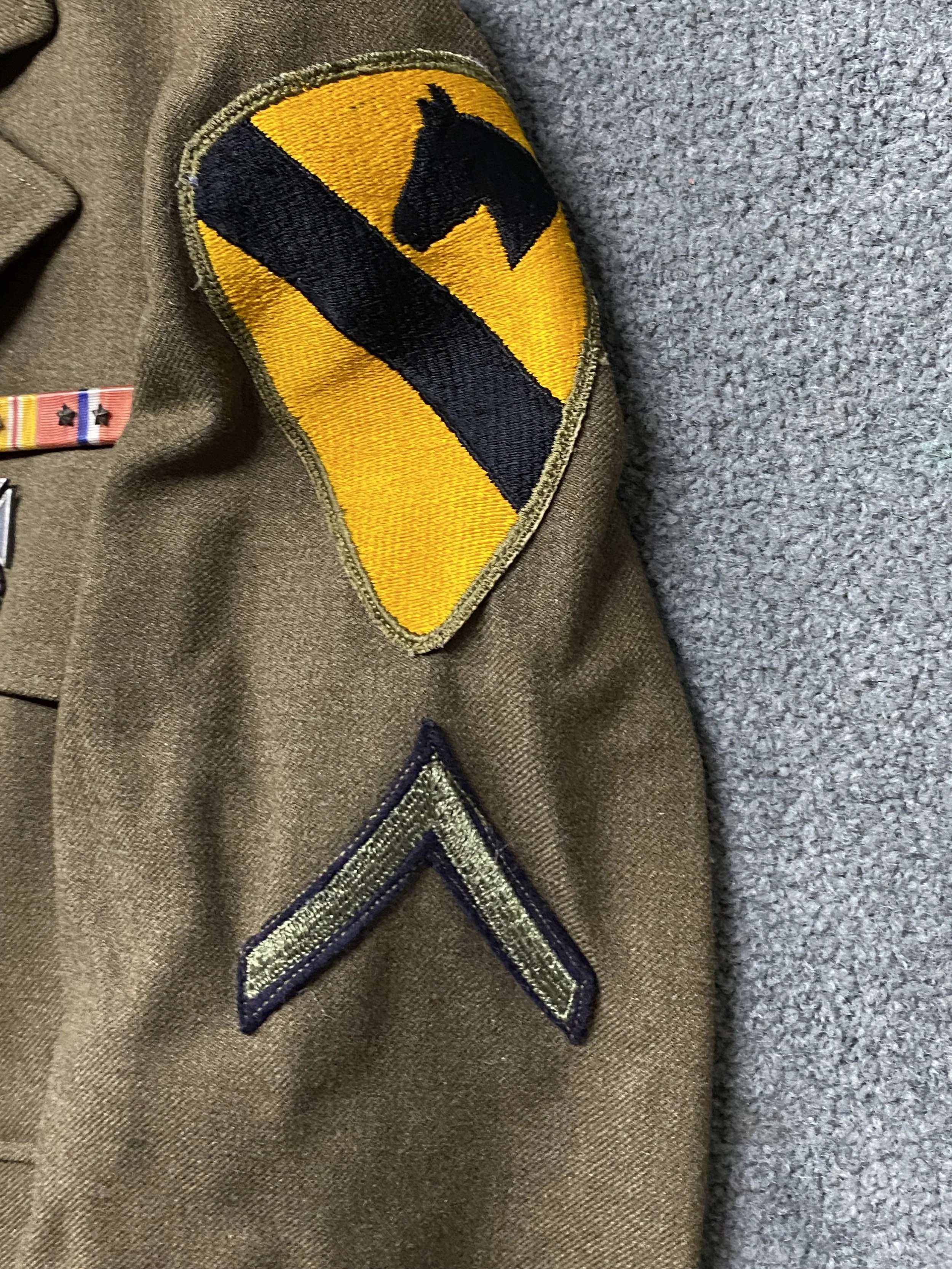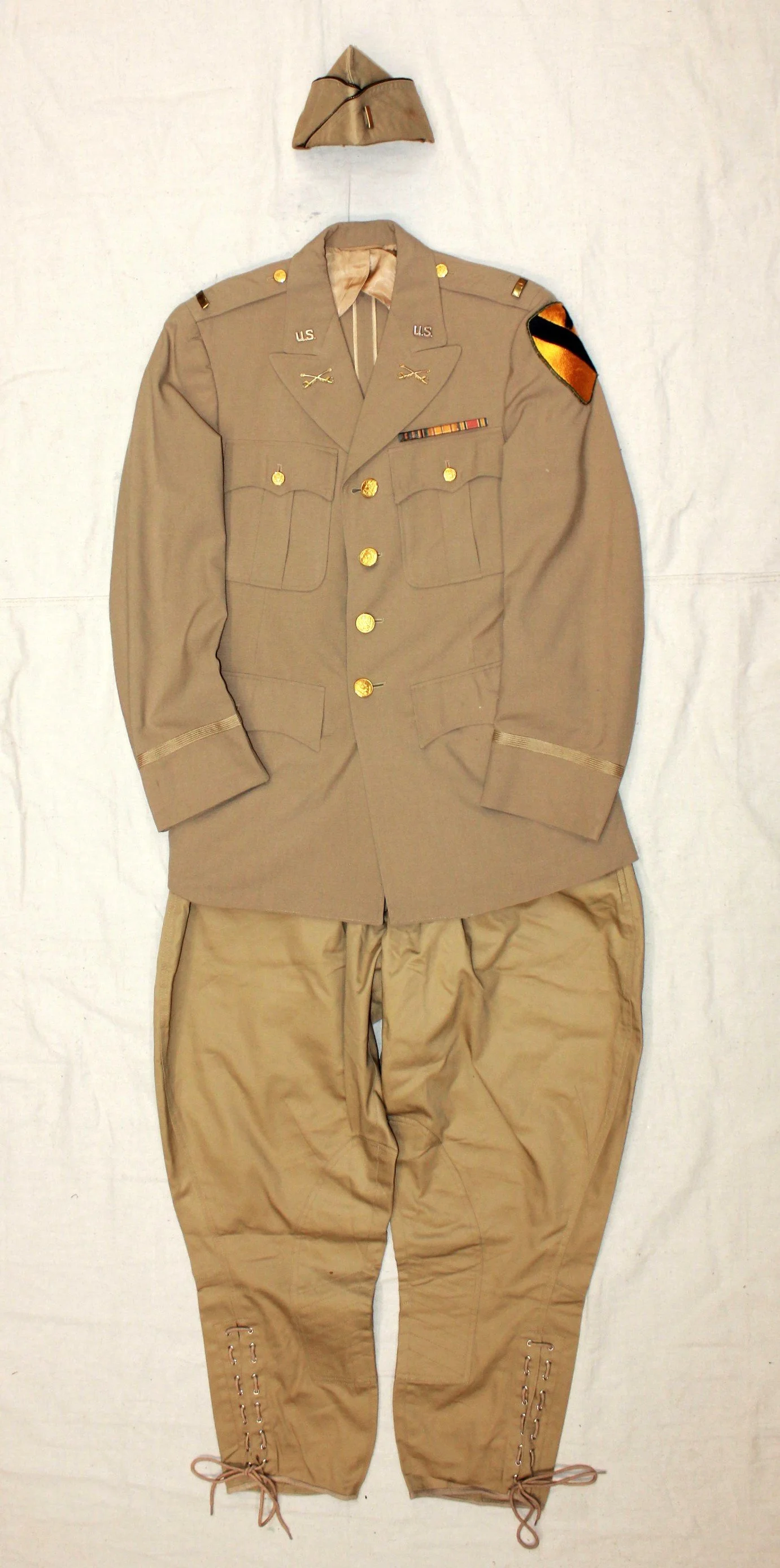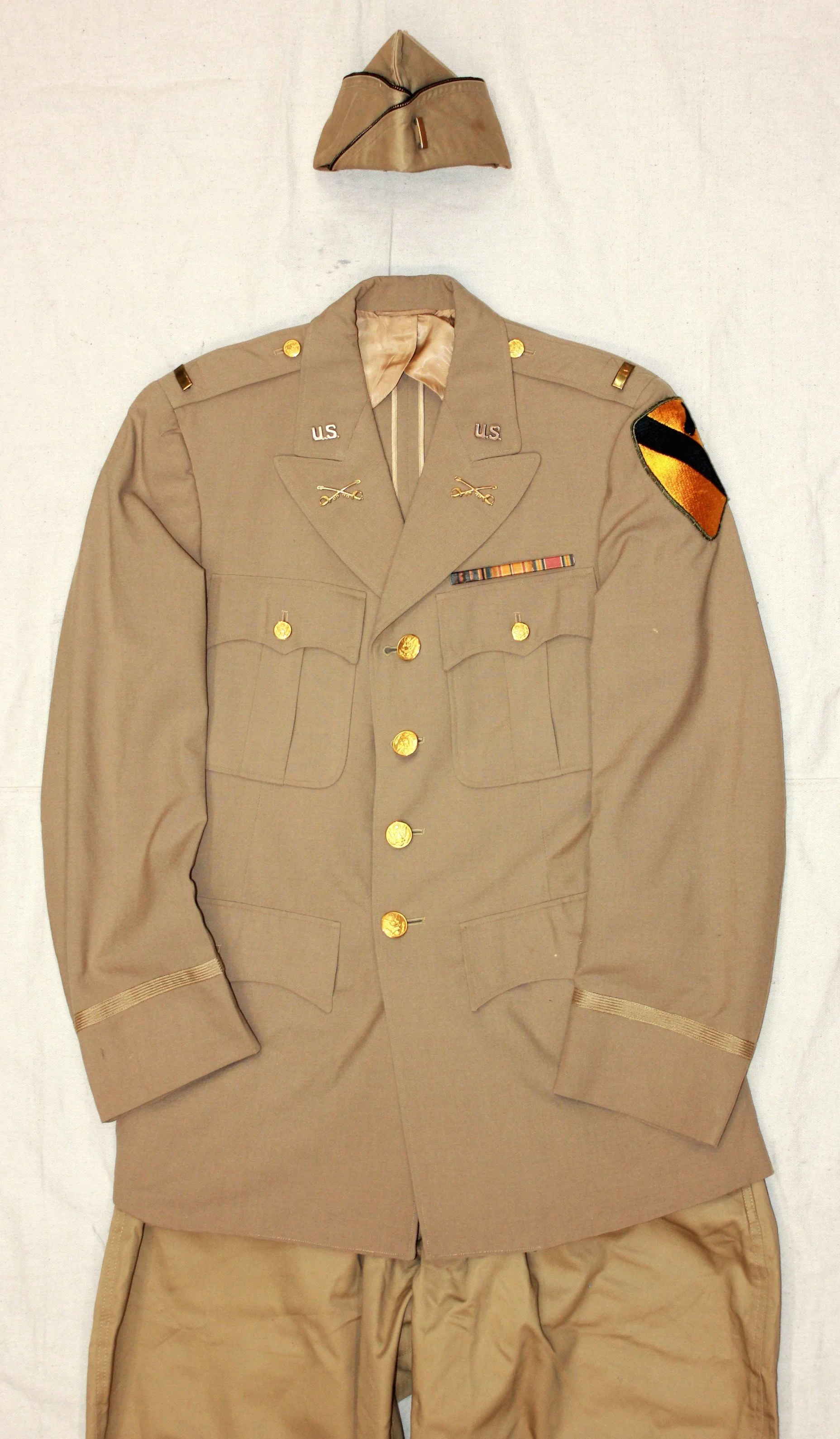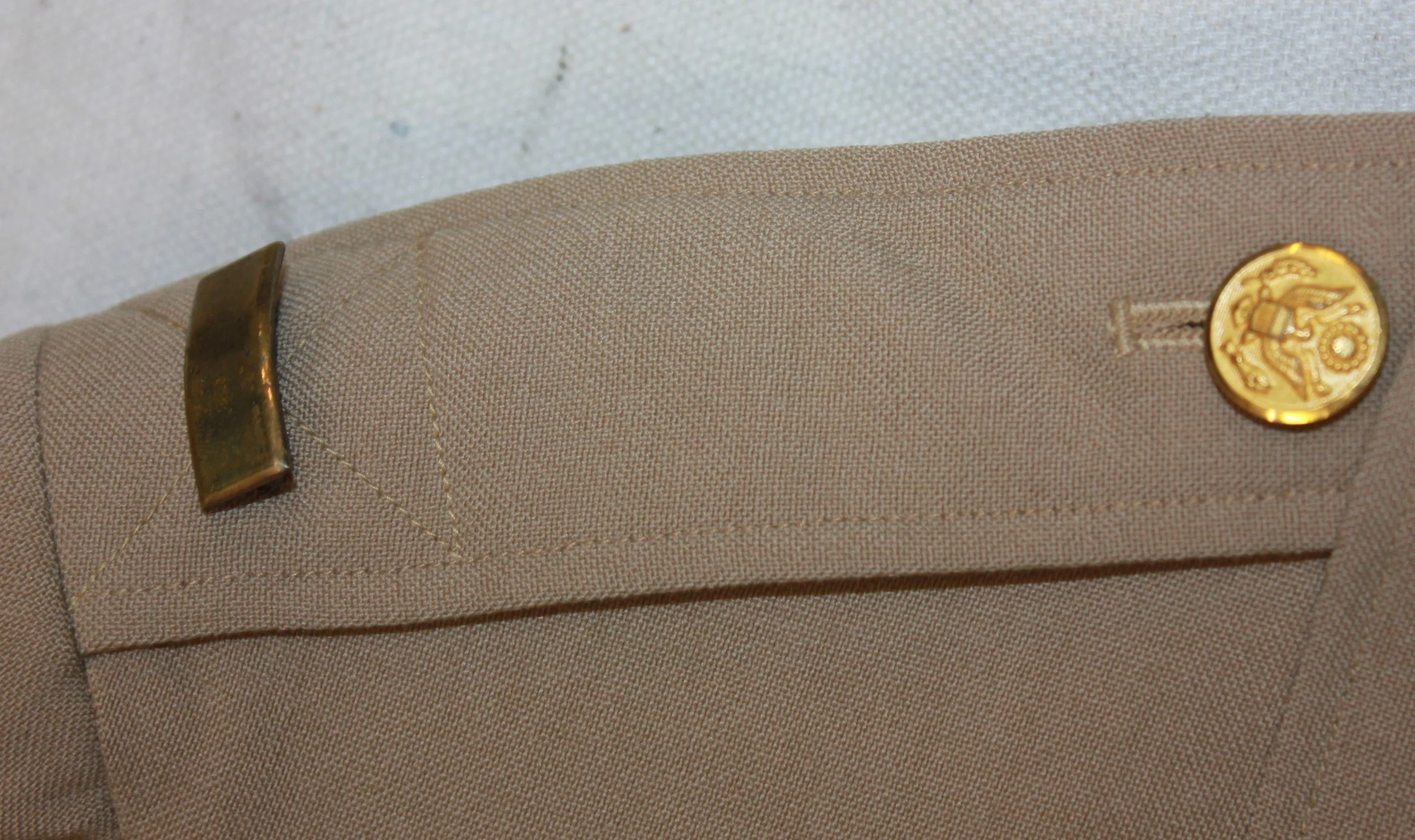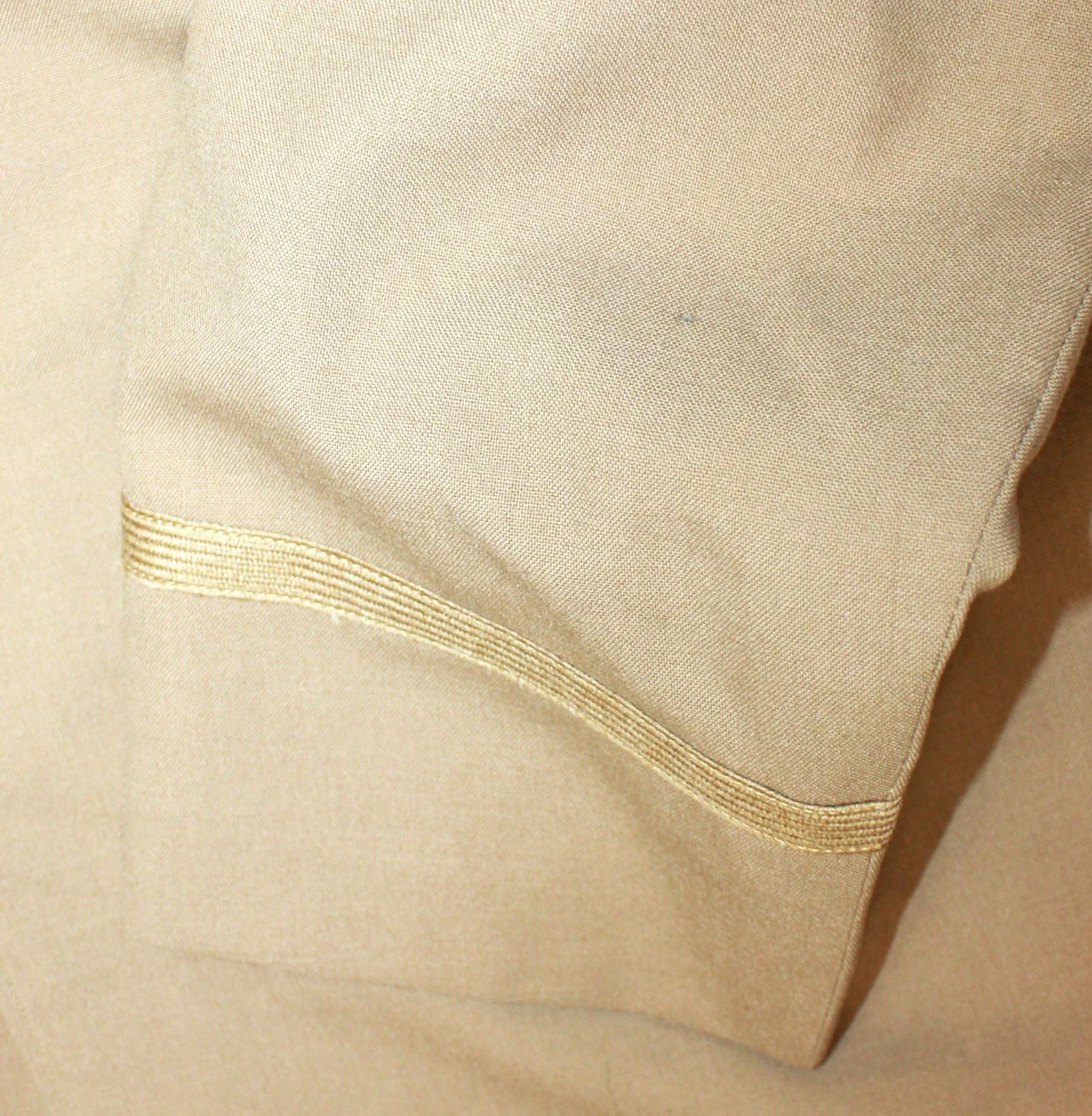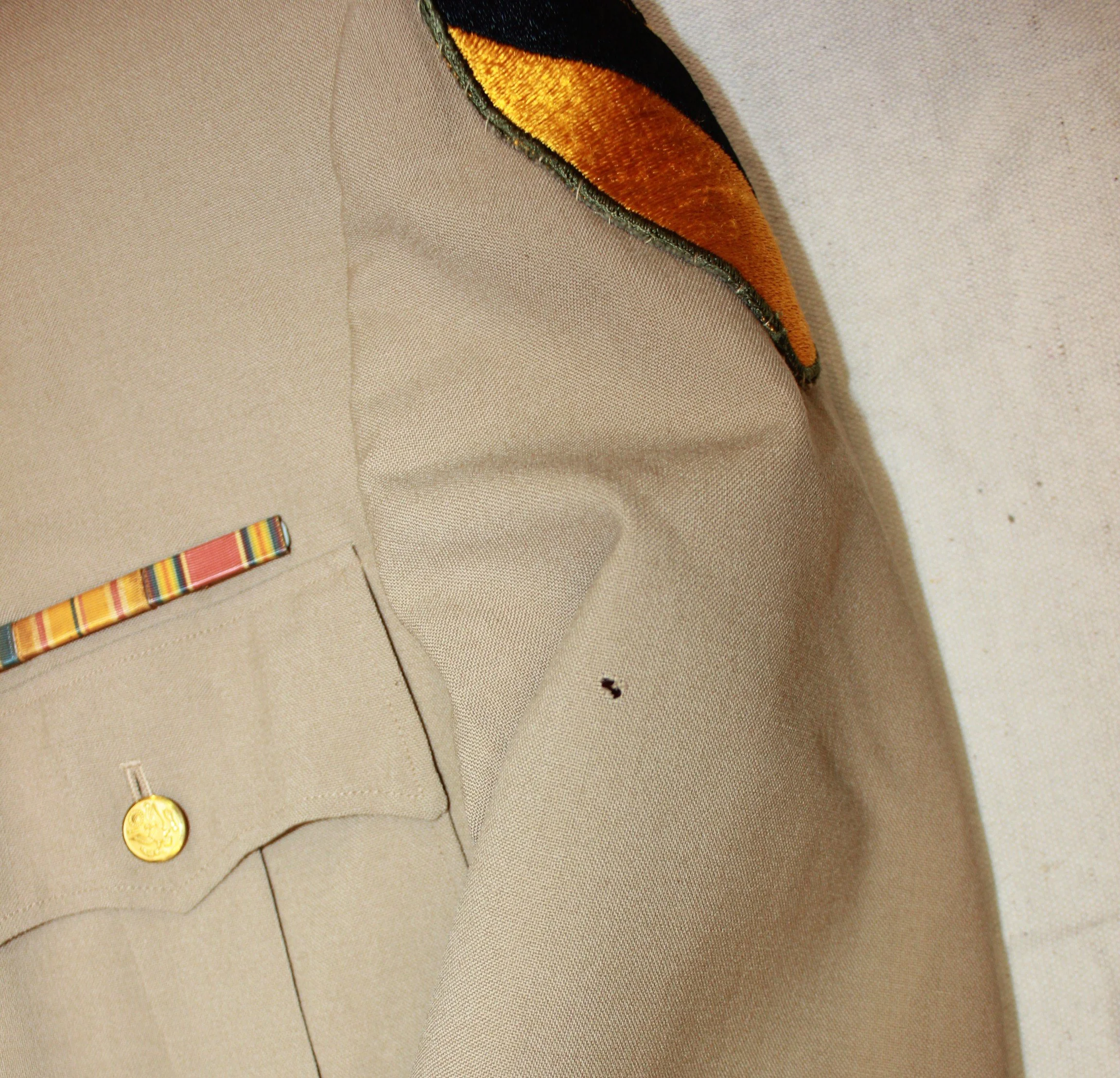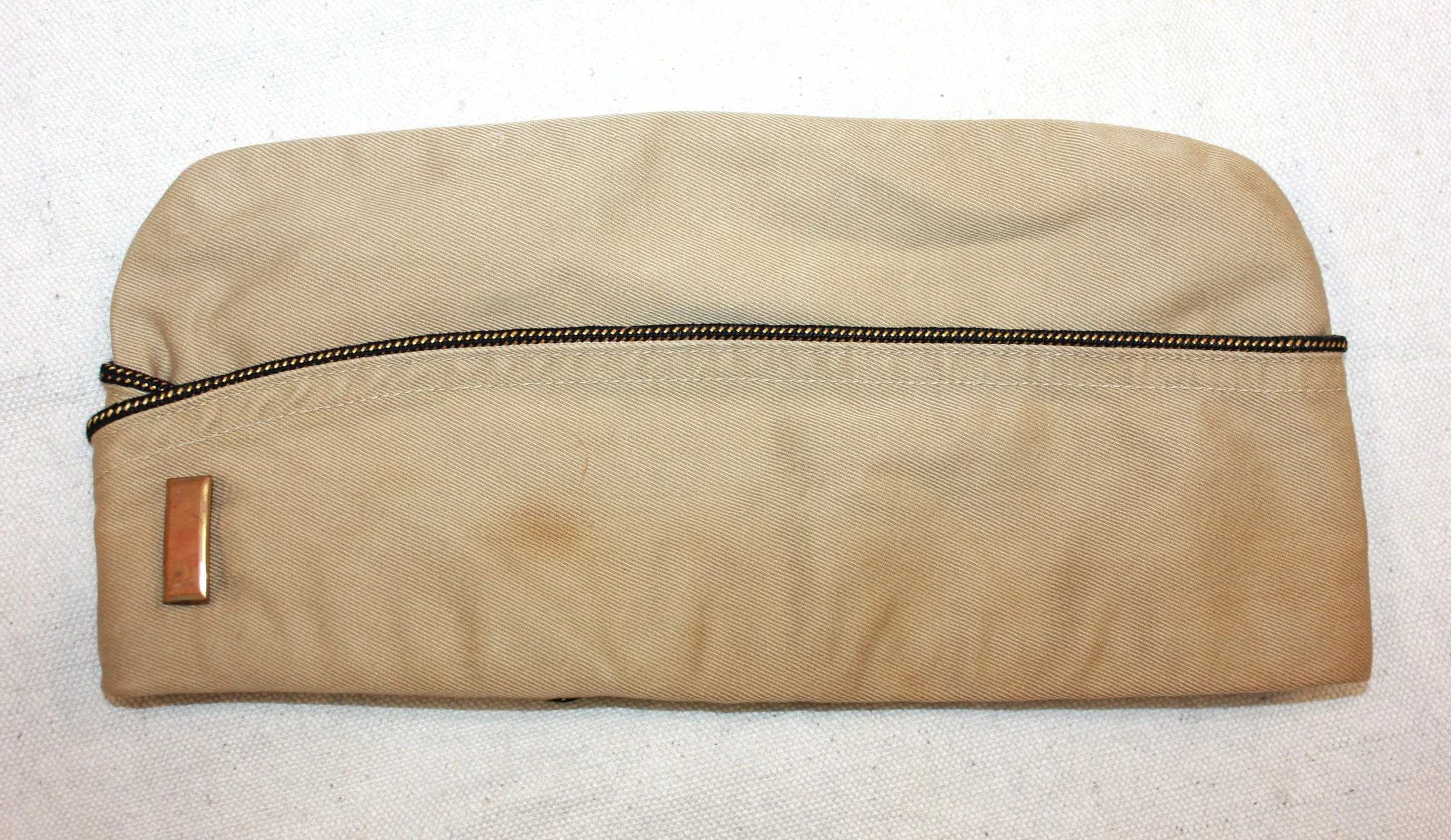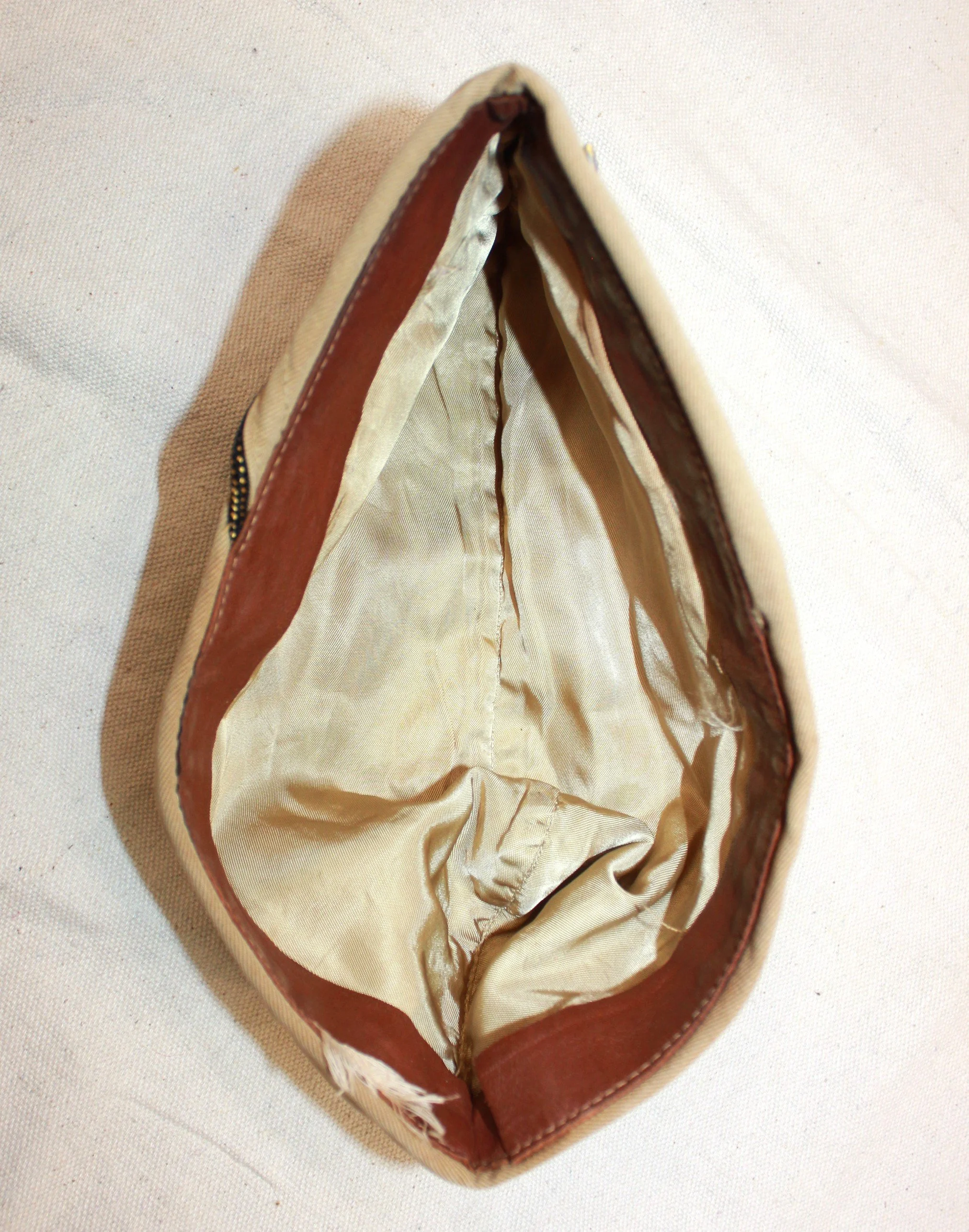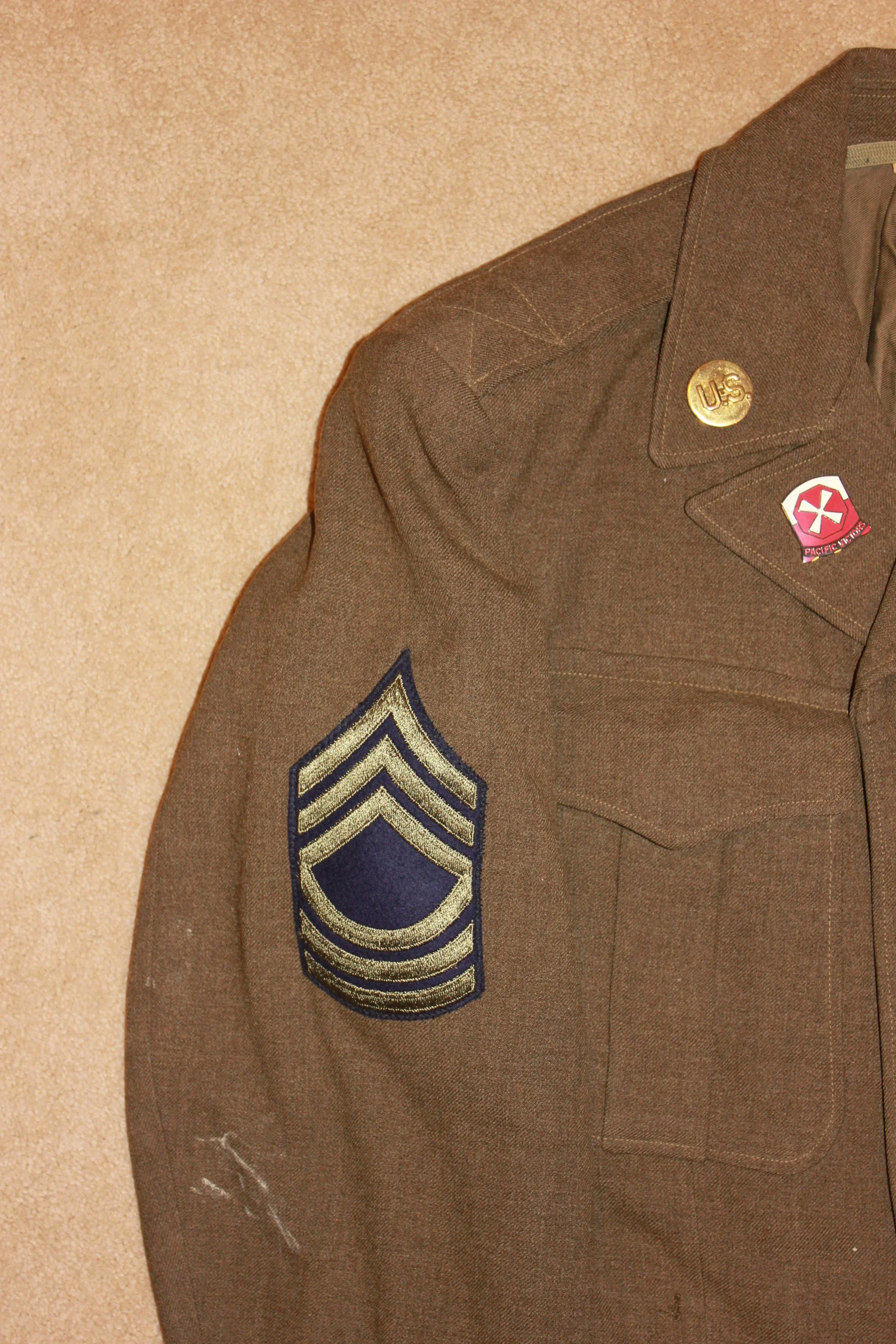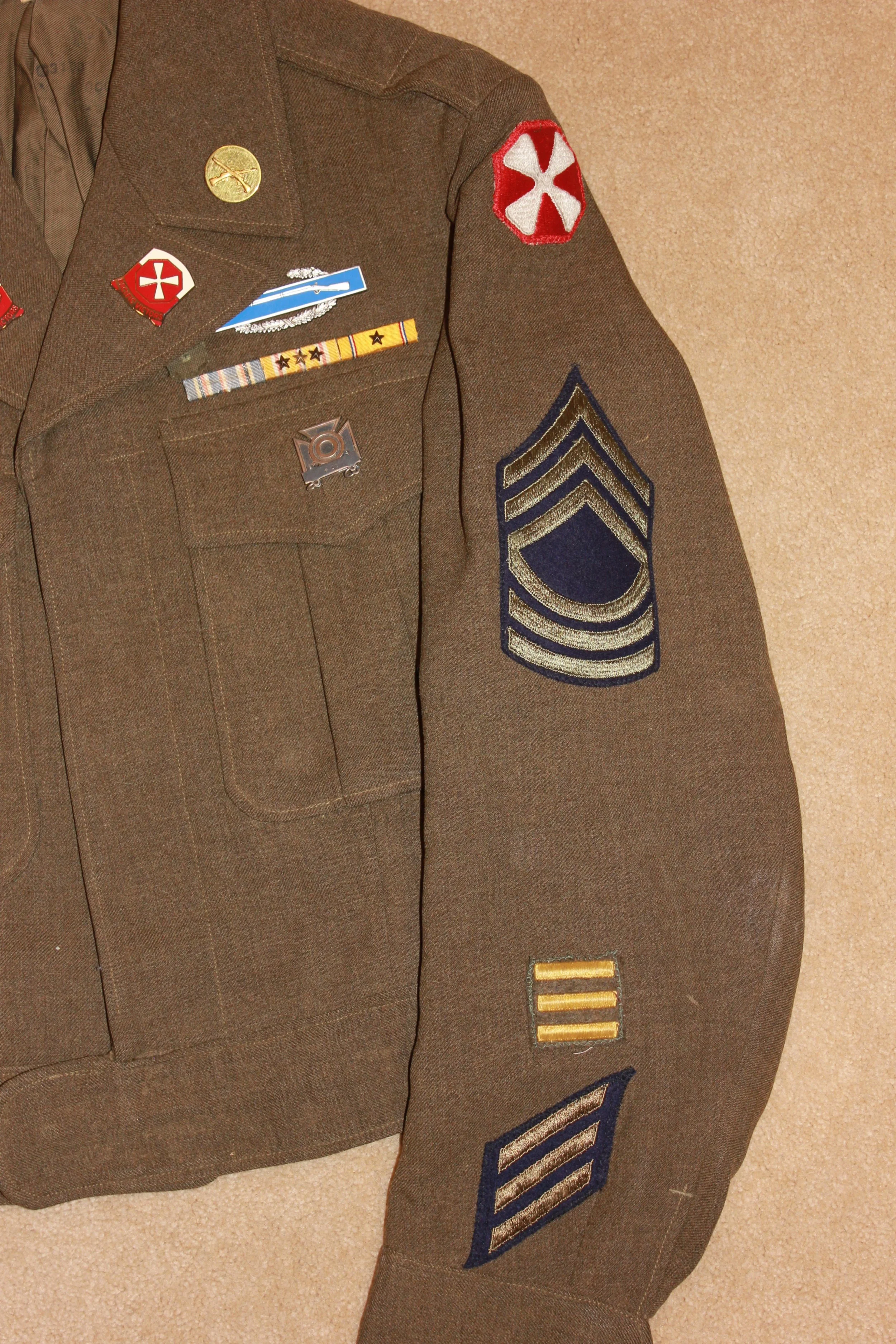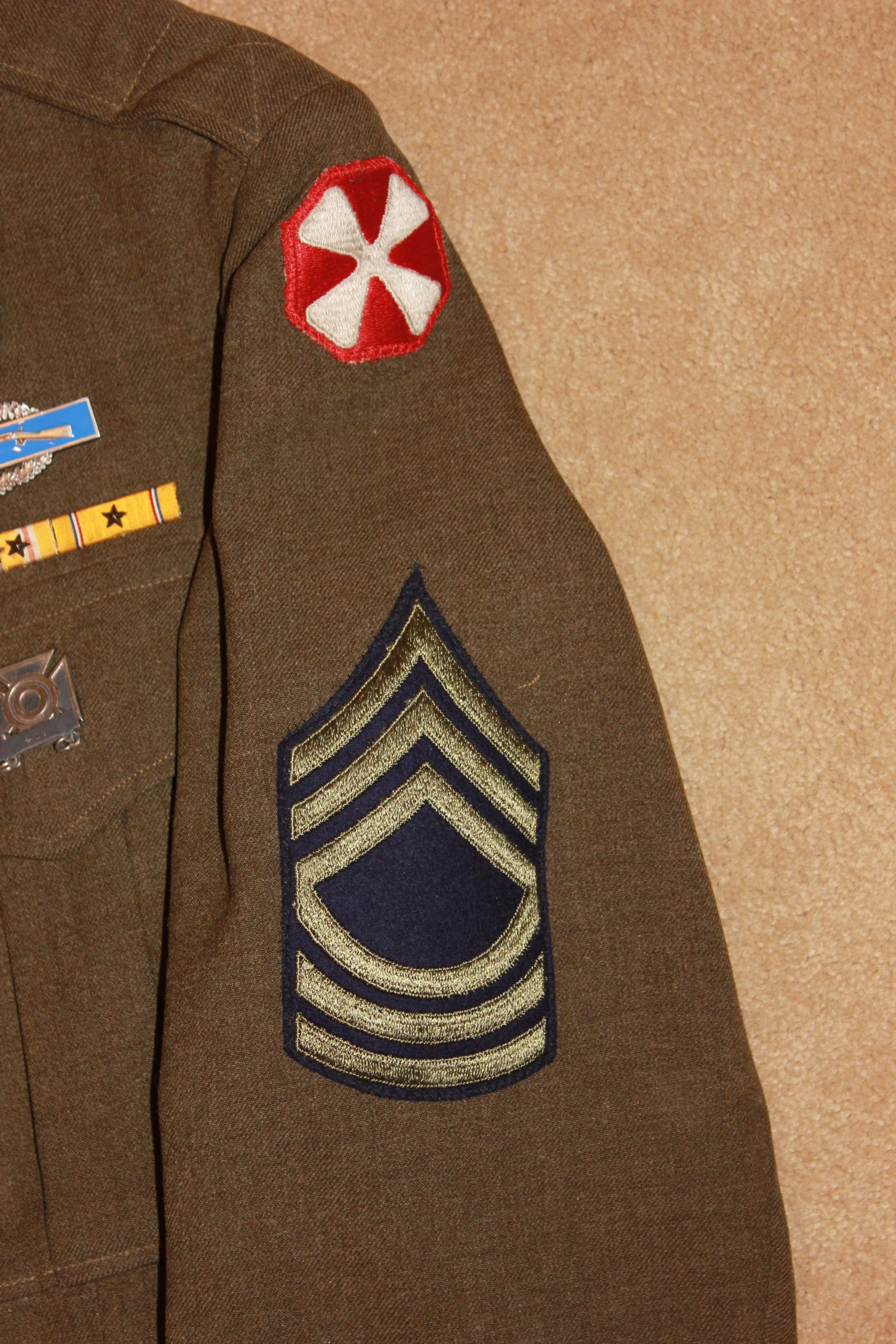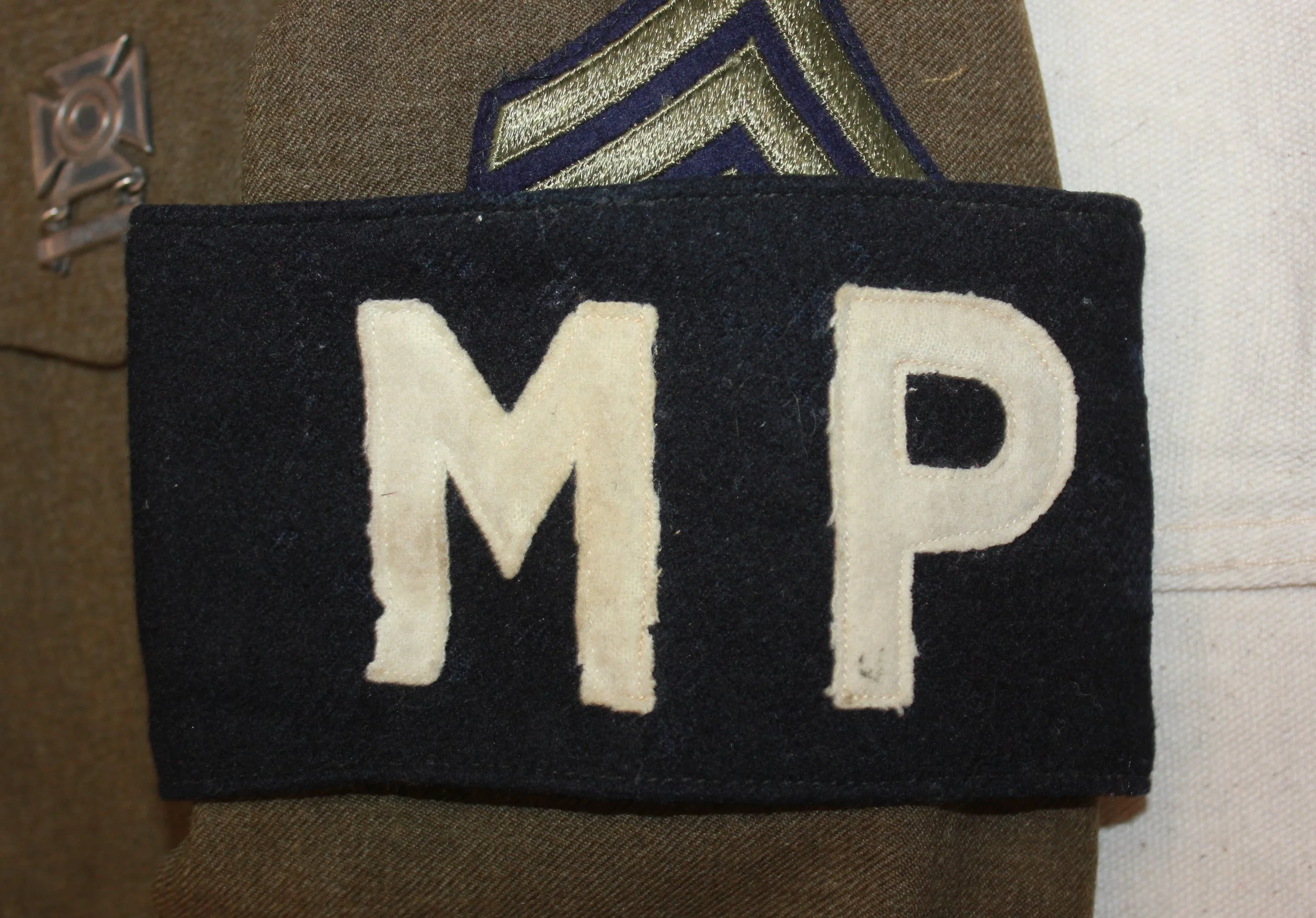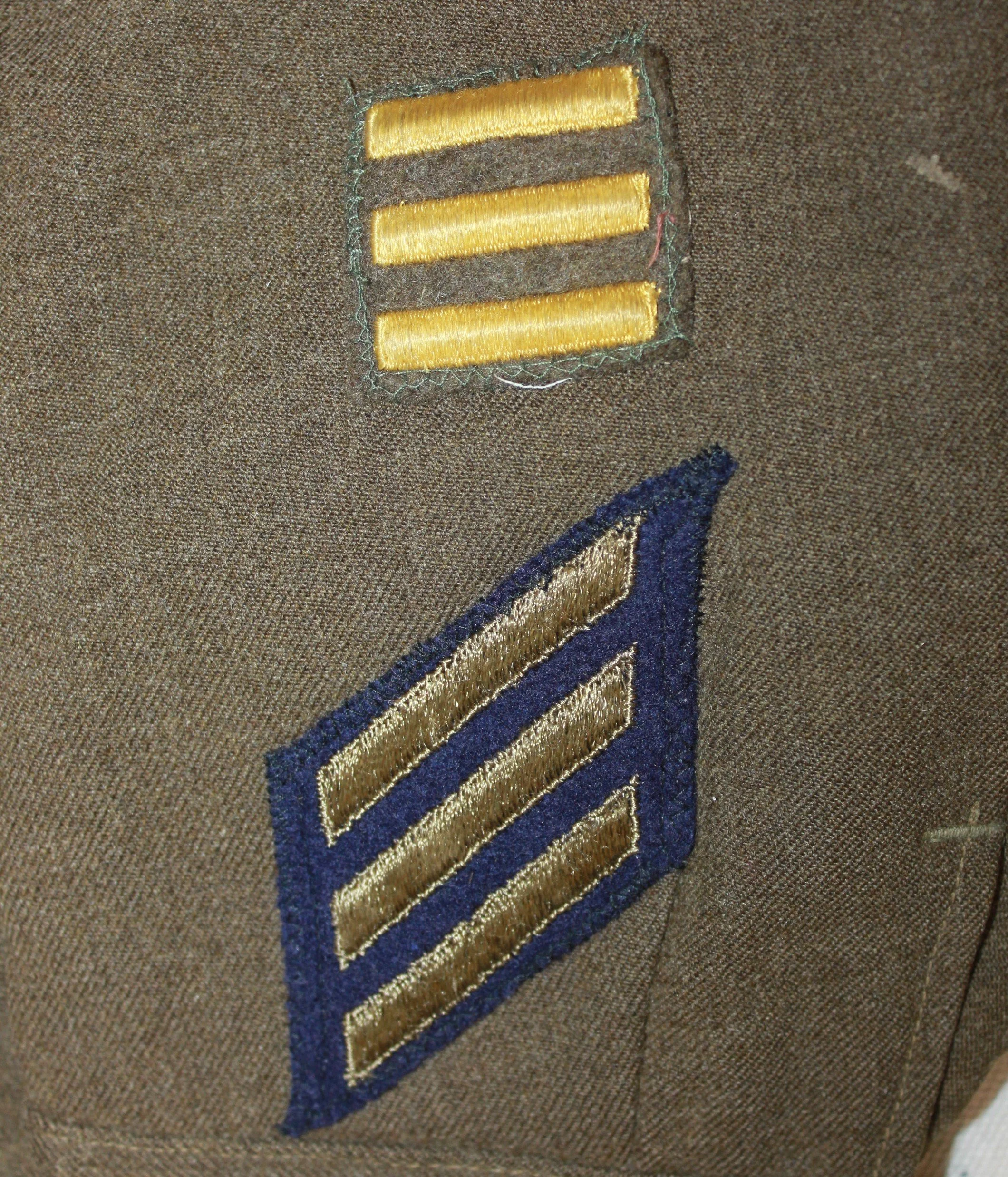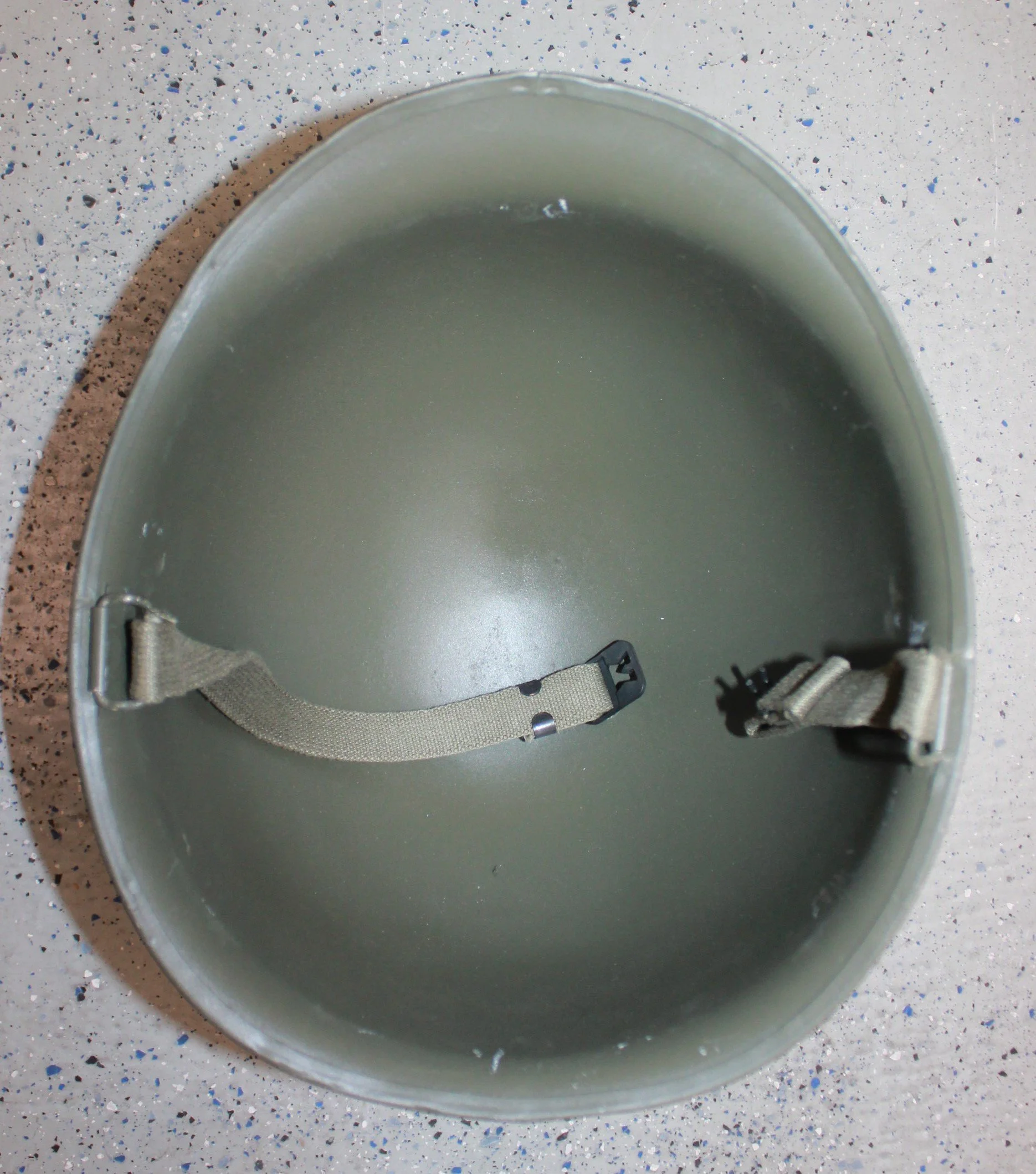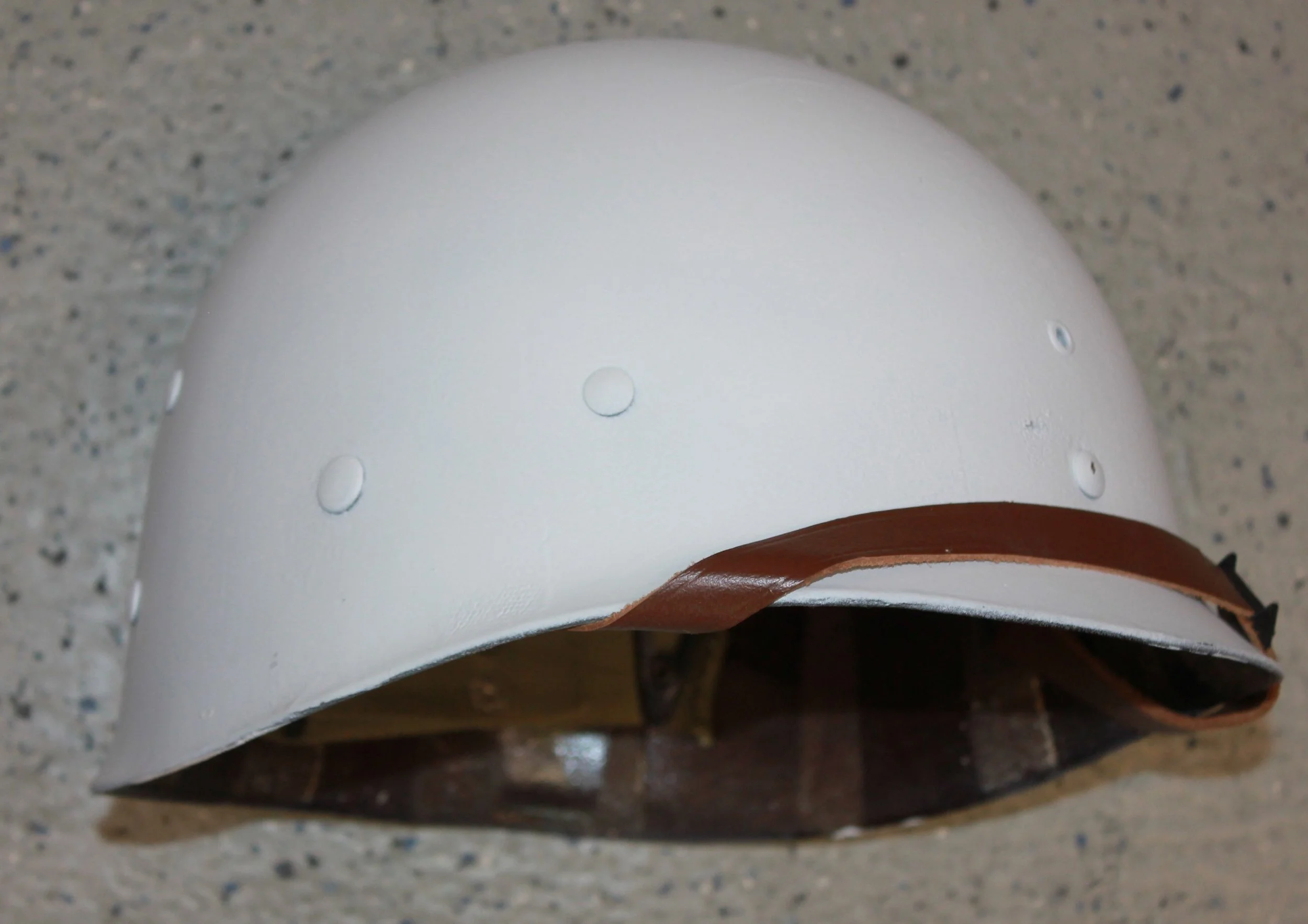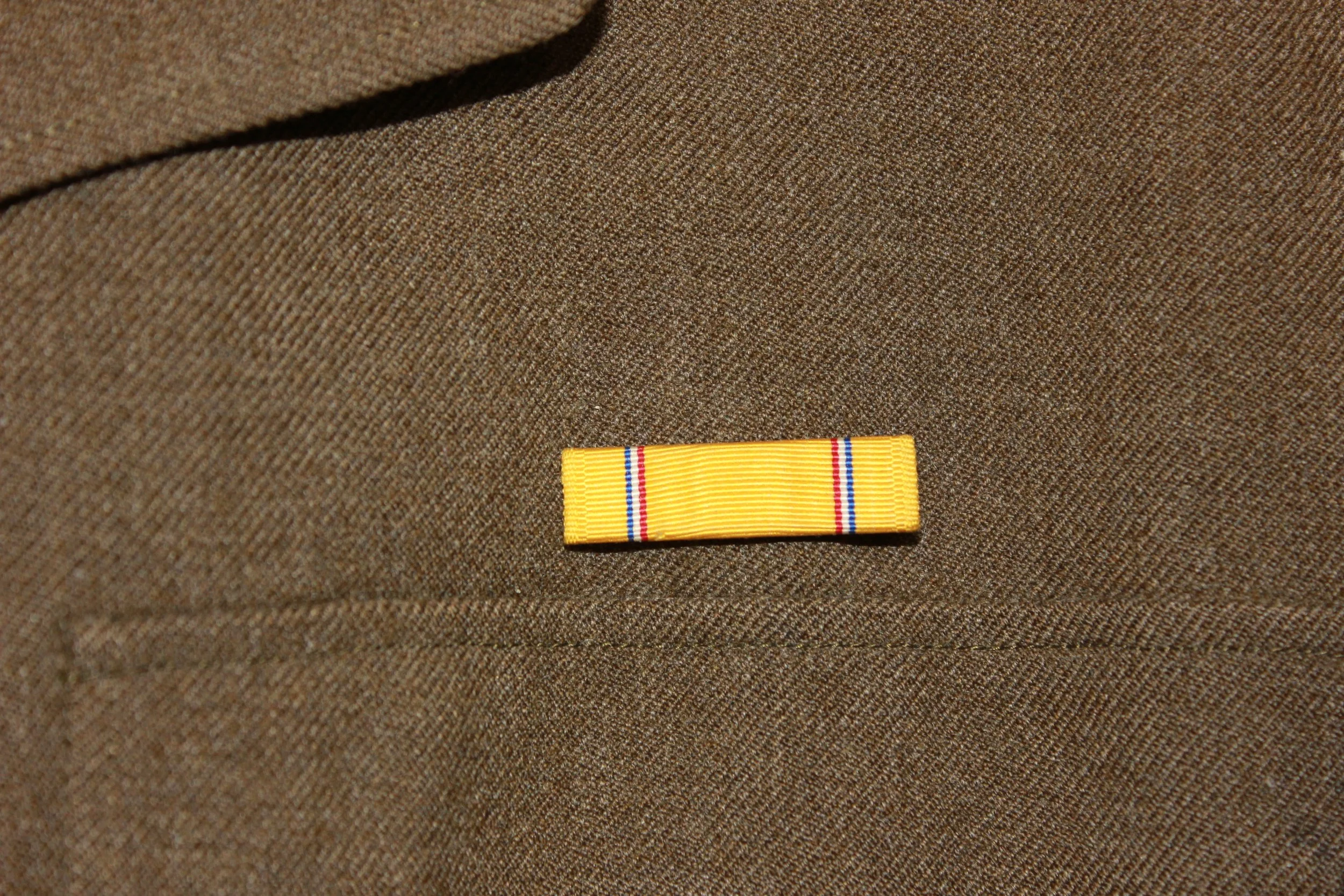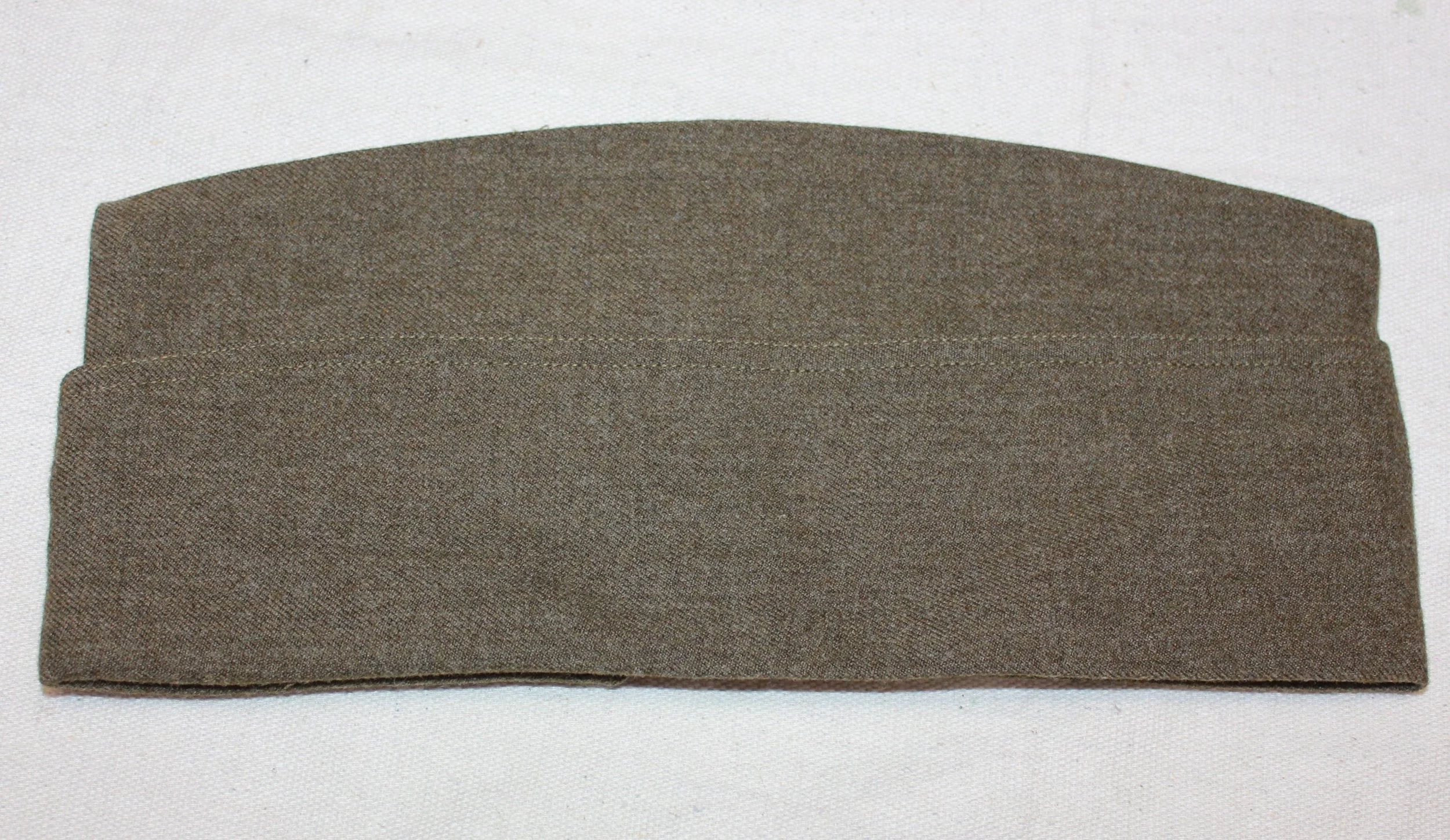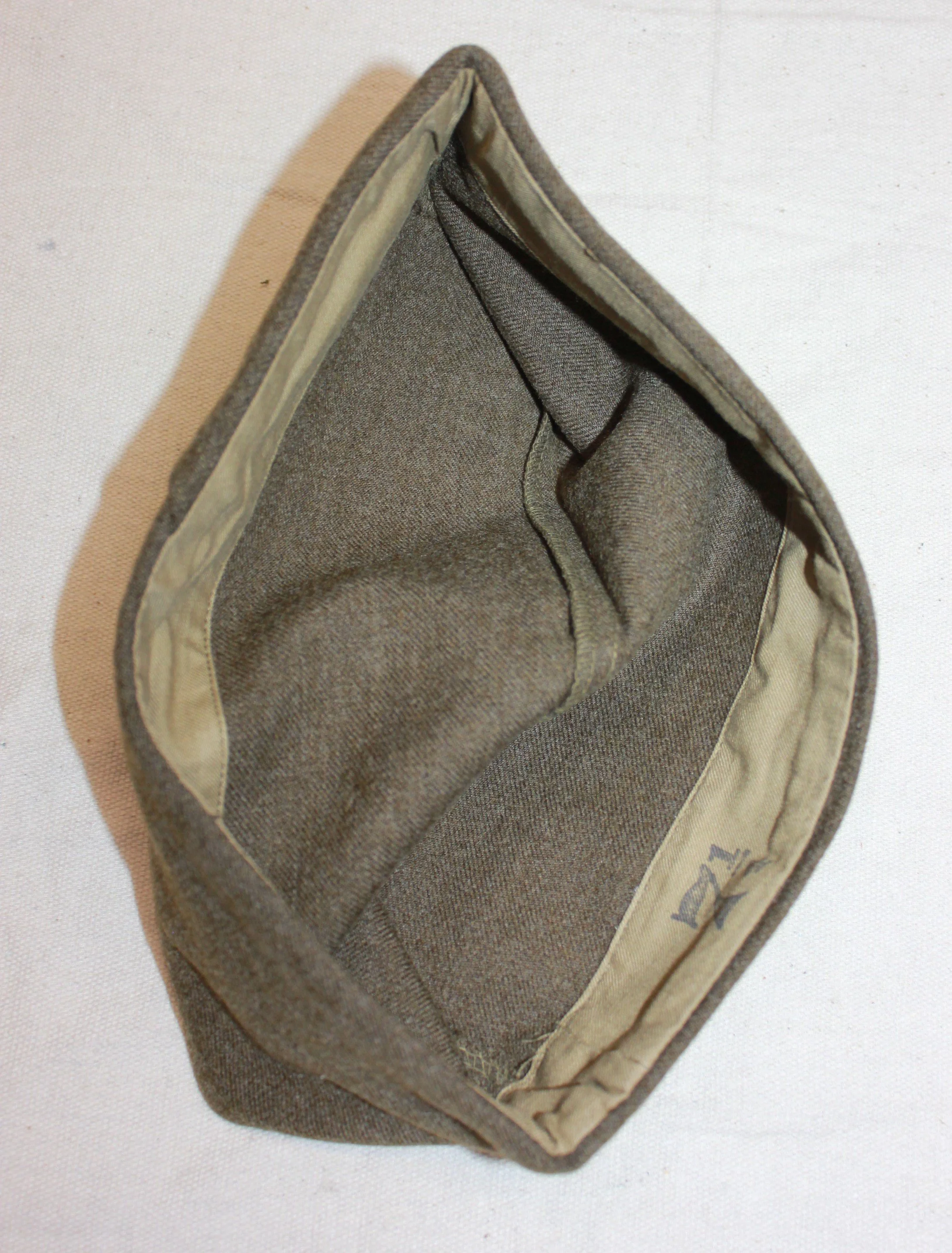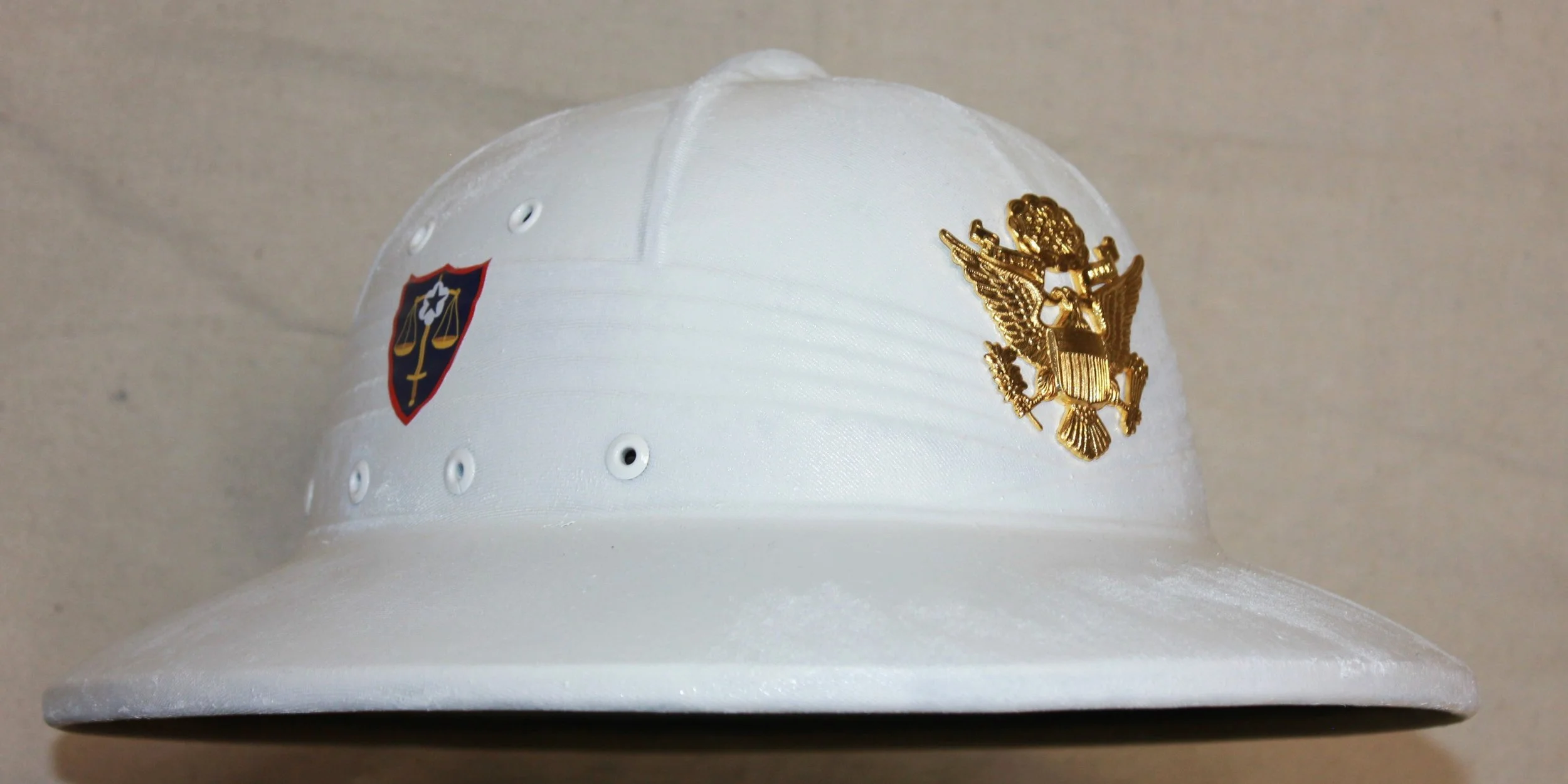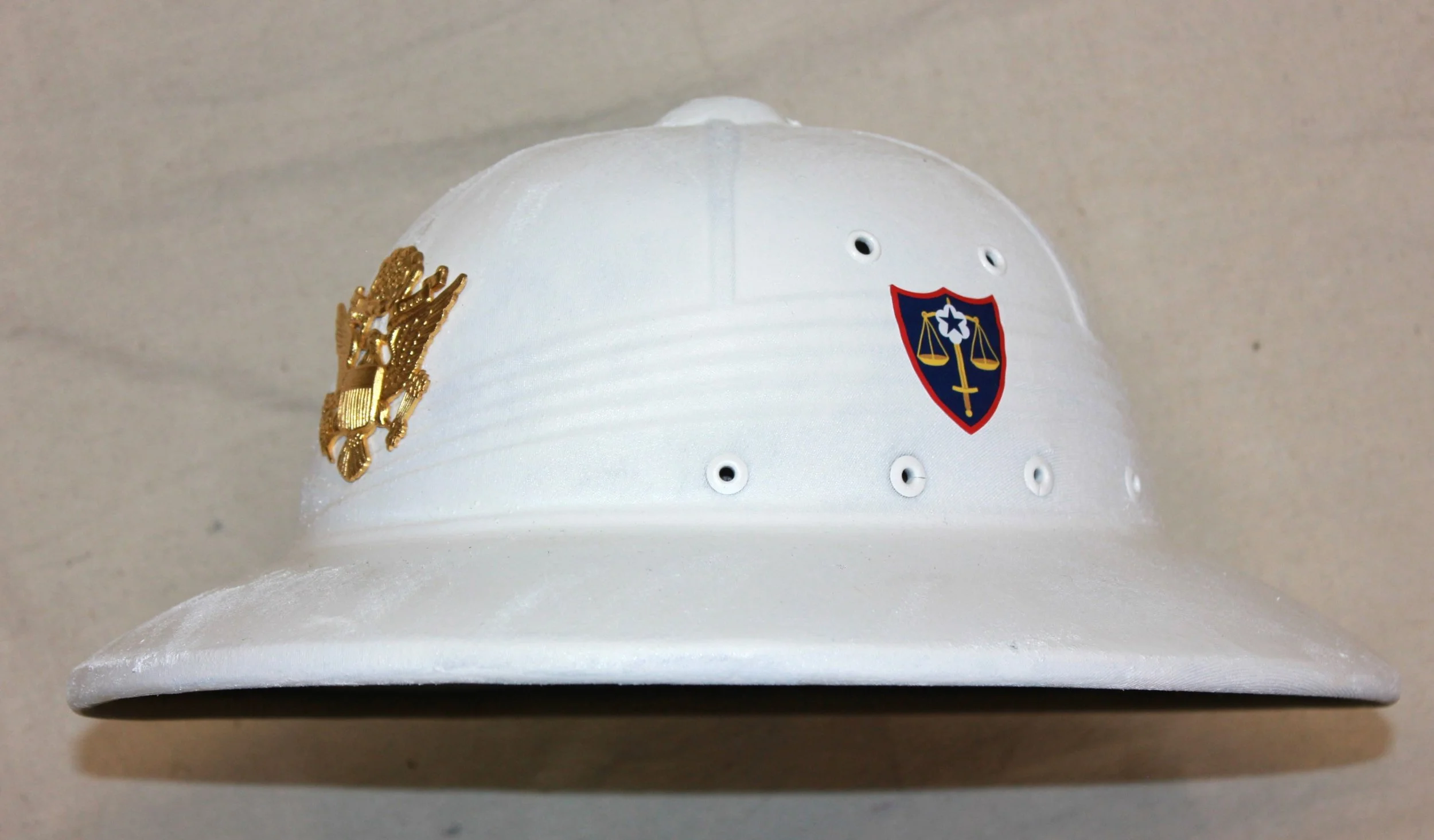U.S. Army Pto, operations, Occupation & War Crime Trials:
77th Infantry Division, in the South Pacific:
The uniforms of WWII were in development and went from the WWI uniform and format to the 1940 look when war broke out. So, a simplified look went on the board and the factories geared up quickly to produce light uniforms for Asia and the Mediterranean quickly like.
The 77th was deactivated in May 1919 and reactivated for WWII in the spring of 1942. "The Old Bastards," as they were nicknamed, were part of the Organized Reserves Corps and began training at Fort Jackson, SC, in March of 1942. This outfit was fought at Guam, on 4 August, resistance ending on the 8th. Guam recaptured, the 77th sailed for New Caledonia but changed in route, and it was directed to proceed to Leyte.
The unit was originally activated on 18 August 1917 in preparation for possibly having to go overseas. And they went to France for Service in the First War. In March 1918, the Division went to war, fighting therein such Operations as the Meuse-Argonne and Oise-Aisne. They suffered Casualties in total, 10,194 (KIA-1,486, and 8,708 WIA).
The Division landed on the east coast of Leyte on 23 November 1944, fighting there through February 1945. The next combat assignment was Okinawa. In late March (26-29), the Division made 15 landings, securing Kerama Retto and Keise Shima for the assault on Okinawa. The tropical lightweight uniform was being produced and became the standard for their operations in the Pacific Theater, and it came with a matching "Ball-Cap Style" and a soft cap was an issue.
Riding at sea, 1-15 April 1945, it suffered casualties from enemy suicide aircraft attacks and prepared for the assault landing on Ie Shima. On 16 April 1945, the 77th landed on Le Shims and engaged in a bitter fight for "Government House Hill" and "Bloody Ridge."
There was much fighting for the US. Army in the Tropics, the Island-hopping campaign fought from the Aleutians to Wake, Palau, Leyte, and the Philippines, Guam, to Okinawa, and Tinian, and would have invaded Japan had the A-bomb not been used. The War with Japan cost both sides horrifically. This photo is of the leader of the Cabanatuan Raid in the Philippines.
In this operation, Ernie Pyle was killed. On 25 April, it left Le Shims for Okinawa, then in July the Division moved to Cebu, Philippine Islands, and prepared for. The invasion of Japan. The Division landed in Japan in October 1945 for occupation duty and was inactivated a few months later 15 March 1946. The "Boonie" Style-Tropical cap came out and was popular in the heat, sometimes rolling up the sides on patrol; they worked well in the monsoon rains too. This cap is in the same material as the uniforms too, and the very-WWII Color Blue/Green.
Having been reactivated on 25 March 1942, they went to War on 24 March 1944. They served in the Western Pacific, Southern Philippines, Ryukyus Campaigns and earned 16 Distinguished Unit Citations. They were inactivated on 15 March 1946 while on occupational duty in Japan. Located at Fort Dix, New Jersey, since its former command, then in 2008 at Fort Totten, Bayside in Queens, the New York-77th Regional Readiness Command was disestablished.
Early on, the United States Army was still wearing the M1917 "Steel Pot", Which was near the same as used by England, Australia, New Zealand, India, Poles, etc... and with little difference, the US. had its own color green. The helmet that became the standard was in production from the get-go, but it took a while to reach all the men and women out there fighting for the US. It would be the standard from 1942 to sometime in the late ’70s, I think.
The interesting thing is that all the forces that used the M1 Steel Helmet, it was used threw the post-war and into the Cold War times, and found use in South America, and many other countries, some making their own versions that don't match up with the US-made M1s.
The helmet sheen here, just because it was worn in the WWI era, and the early stages of the conflict in the pacific, and how most of these helmets looked when they were bought, most have been at least repainted because the rust will eat them up, and I want to preserve them to some extent, many have been complete restorations at great expense-i’ll never get my money out of them, but they were brought back to issue condition in most cases. These differed in the head adjustment band, with later M1 Helmets that used a separate liner. The helmet’s padding here is original, and as it came. This 'Issue' brand-new look is a deliberate show of how they came. This is an impeccable example and a nice helmet. Assault Craft approach beach red Attu, Holtz Bay, May 11, 1943. These folks got a different uniform, and it was much heavier wool pants, sometimes waders, and Oilskin (Overalls). and heavy Coats...because it was much colder here, something few were prepared for.
Attu Invasion, Task Force Mackinaw Coat:
The Aleutian Islands campaign was fought between the United States Military and Imperial Japan. It took place at the end of the Aleutian Island chain, in the then-territory of Alaska. This was considered the American theater and the Pacific theater at the same time, starting on 3 June 1942.
Japanese forces had landed on and occupied the islands of Attu and Kiska. The lopsided force was a small diversion for the Japanese, but the US reaction was huge; the Japanese held them off for nearly a year. The conditions there were equally tough on both sides, though.
The fear for the US was that the trade route of the great circle would be affected by the strategic location. It could affect the control of Pacific transportation routes. And it was nothing like how the users do every day at present.
The Japanese thought control of the Aleutians could prevent a possible U.S. attack across the Northern Pacific. Similarly. The US Command figured that if lost to the Japanese, it would allow the enemy to attack the Pacific Northwest.
Attu was invaded by a task force on May 11, 1943, and a bitter battle followed. At the end of it, the Japanese did a banzai charge on May 29. On August 15, 1943, they were cut down. The invasion force landed on Kiska after a sustained three-week barrage, but in the dense fog, the Japanese had evacuated the island on July 29.
The loss of Attu had been relayed to the Japanese Command at Kiska, and they knew what was coming. So, they started an evacuation because the imminent attack by larger Allied forces was clear, and the Japanese removed all their troops on July 28 under the cover of severe fog. This was completely missed by the Allies, and Allied casualties during this invasion were many, nearly 200. Itchy trigger fingers and slightly different uniforms caused part of the problem, and advancing from different sides, as well as mines and booby traps, U.S. and Canadian forces reported there were 28 Americans and four Canadians dead. Even though there was no enemy on the island, Trench foot and other sicknesses prevailed. The destroyer USS Abner Read had hit a sea mine, resulting in 87 casualties.
Interestingly enough, the Imperial Japanese Navy also had the same problem in the fog of war, while on approach to retrieve their men on Little Kiska, they had come under attack, and shelled and attempted to torpedo the island. Often said in history books and movies, it is depicted as merely a diversion in advance of the Battle of Midway; still, some historians believe it was to protect their northern flank.
The Japanese invasions and occupations of Kiska on June 6 and Attu on June 7 shocked the American public. The continental United States had been invaded for the first time since the War of 1812. The Japanese at first did not mess with the local populace, the 'Unangax', aka Aleuts. But then, in September 1942, the Japanese Aleutian strategy shifted. All the Natives were sent to Hokkaido, Japan, and placed in an internment camp. So on a sad note, the US. The government also then moved the local Unangax in the Aleutian Islands to internment camps in the Alaska Panhandle, to be away from the war, but not all came back.
Admiral Ernest King later reported to the Secretary of the Navy, Frank Knox, that the only things that remained on Kiska Island were dogs and freshly brewed coffee. Knox asked for an explanation, and King responded, "The Japanese are very clever. Their dogs can brew coffee."
U.S. General Billy Mitchell stated to the U.S. Congress in 1935, "I believe that in the future, whoever holds Alaska will hold the world. The US Government, some 7 years later, obviously agreed.
This is a uniform that I have a different connection with, this is about the Aleutians, the Bering Sea, and the Pacific Ocean. I fished out of Dutch Harbor, Cold Bay, King Cove, and the surrounding areas. The Pacific and the Bering Sea are two different animals; the Bering Sea is Tall and close together; the Pacific can get tall but further apart, and of course, not to mention the tides and currents, the cold there is blinding, sideways-moving snowflakes….I read some books on the battles there, and walked over some of the battle-grounds, the old docks, and the aerodrome. This is for soldiers who served up there, and the ones who passed, a tribute to both Japanese and Americans, and the Canadians, 40 years ago, all the locations still had Quonset huts and fine wood barracks, gun emplacements, and trenches everywhere! and many vehicles, just left there, distributors gone, and salted fuel tanks., The docks had been dismantled when the military left; it was, well, all still very clear.
1st Cavalry Division, WWII:
The First Cavalry Division goes back to August 31, 1921, when it was activated at Fort Bliss in Texas. And when the War came, at the end of 1941, the 1st Cavalry Division was being used to patrol and guard the US. / Mexican border, and they were called upon to defend the world from the Japanese, but they were held back, for various reasons, basically staying as reserves.
The 1st Cavalry's number was pulled after many a soldier had already served in the fighting in the Pacific. The Division deployed to Australia on July 11, 1943, where they continued training at Strathpine, Queensland, until 26 July, when they moved to New Guinea to stage for the Admiralties campaign in the Bismarck Archipelago. From 22 to 27 February 1944.
The Division had its baptism of fire on February 29, 1944, during the landing on Los Negros Island, in the Admiralty chain. They then were involved in the Philippine campaign, landing at Leyte, where they were involved in heavy fighting, then at Samar, and the Luzon Islands. By the end of the war, they had seen plenty enough action and done their part. They would be part of the occupation forces of Japan, honored to be the first United States division to enter Tokyo.
They were called in a couple of times to stand up and control labor demonstrations, strikes, and rallies in 1948. And it has been said they helped with the repatriation of Japanese soldiers and civilians, transporting them back to Japan, from to liberated islands of the Pacific, later in 1945 and early 1946. The Division stayed in Japan until the outbreak of the North Korean attack on the South, and they were called in, entering combat in Korea on July 18, 1950, and the war lasted 3 years.
But First Cavalry Division is more famous for turning in its Horses for Helicopters when they transitioned to an Air Mobile Operation, to prove the new concept in the 1960s of air envelopment, a spin on the WWII Paratrooper operation, and used heavily in the Battles in Vietnam. Having derived from a Horse Cavalry Unit, the 1st Air-Cavalry Division is now one of the most decorated combat divisions of the United States Army.
The 1st Cavalry Division has served in World War II, Korea, Vietnam, the Persian Gulf War, and the Stabilization Force in Bosnia-Herzegovina, and they actually went to Iraq several times and went to war in Afghanistan (2001 & 2014) and in Operation Freedom's Sentinel, and they are probably still there, with the 101st Airborne.
The 1st Cavalry Shoulder Patch. A large Norman Shield, in Yellow, the traditional cavalry color, and the horse's head refer to the division's original cavalry structure; the Black is symbolic of iron and alludes to the transition to armor. The black diagonal stripe represents a sword Blade, a mark of military honor; it also implies movement "up the field,” and the number 1 symbolizes aggressive elan and attack.
The uniform represents the early period, with the issue of the lightweight HBTs so commonly used in the tropical from 1943 till the end of the war., and he could have various special-kit, for example, heavy weapons teams, like mortars, or machine-gun, or medic, etc, or just kept what was needed water and bullets, all depends on his assignment, place and time.
1st Cavalry Division, Private, Occupational Forces, Japan 1945.
The First Cavalry Division is Famous for its transition to an Air Mobile Concept in the 1960s, and the Battles in Vietnam. It, however, did derive from a Horse Cavalry Unit, the 1st Cavalry Division they called the "First Team," which is one of the most decorated combat divisions of the United States Army. This uniform is displayed as is, as per norm, it came as is, no hat, no trousers, unfortunately, this is the way you get them, generally no insignia, maybe a patch.
They were at Fort Hood, in Texas. And it still had Horses in the inventory in 1943. The unit was formed in 1921, and they served in World War II, Korea, Vietnam, the Persian Gulf War, and the Stabilization Force in Bosnia-Herzegovina. and they went to Iraq several times, and went to war in Afghanistan (2001 & 2014), and in Operation Freedom's Sentinel, they are probably still there.
1st Cavalry Division arrived in Australia as shown above, continued its training at Strathpine, Queensland, until 26 July, then moved to New Guinea to stage for the Admiralties campaign from 22 to 27 February 1944.
His Collar Insignia carries the Cavalry-Crossed Swords, on a round plate in brass. The 4-pocket blouse is an on-base "Barracks Uniform" they wore, of course, off base if ever let off base.
Above his Rifle Qualification Badge, he has the American Campaign Ribbon, the Asiatic-Pacific Campaign Medal Ribbon, and the Philippine Liberation Ribbon, the latter two both having (2) Battle Stars on each of them (He fought there).
He does not have an Occupation Ribbon, but may just not have been added to his ribbon bar. And the olive drab-edged 1st Cavalry Shoulder Patch. A large Norman Shield, in Yellow, the traditional cavalry color, and the horse's head refer to the division's original cavalry structure; the Black is symbolic of iron and alludes to the transition to armor. The black diagonal stripe represents a sword Blade, a mark of military honor; it also implies movement "up the field,” and the number 1 symbolizes aggressive elan and attack.
A single Private Stripe, under, tells nothing of this soldier’s experiences in the Second World War- for these were the men at the front most of the time. Their first campaign in the second world war was in the Admiralties campaign, at Los Negros on 29 February 1944. They next took part in the invasion of Leyte in October 1944. The division then invaded Luzon, landing in the Lingayen Gulf area on 27 January 1945.
The telltale marks, His Battle - Overseas Service Bars (OSB's), and Hash Marks = for His length of service, 1 year in battle, the service stripe, green on blue, shows his full 3-year hitch. It had reached Manila by 3 February 1945. The nice brass buttons were used on this type of uniform for a very long time and are a tradition of the Army. The uniform had matching trousers and a side-cap during his occupational duties. The division left Luzon on 25 August 1945 to do occupation duty in Japan, arriving in Yokohama on 2 September 1945 and entering Tokyo on 8 September. They were the first US. division to enter the Japanese capital.
1st Cavalry Division in the Post-War: But here, in the post-war, assignment to Japan was probably considered a good duty. Lots of guarding, drilling, and training, but they did get some off time-and they went sightseeing all over the Islands of Japan.
Though this is in Japan, the long-sleeved shirt is worn while presenting the colors. It may have been a cooler season there. Rarely see the troops in Japan wearing jackets, but obviously, this did happen. The pictures are of a troop guarding a monk as he prays.
“NEW” 2nd Leutnant, 1st Cavalry Division, end of WWII:
“UPDATED, Again” Master Sergeant, 8th Army MP, Occupation Duty in Japan:
The War with Japan...wow, how to explain all of that, it was a vast area involved from China and Burma, Indo-China to the Coral Sea, and the Mariana Islands to the Aleutians. How this came to be, as they were, and how they are looked at now in history may be two different things,....the Japanese Empire in the 1930s was in an expansion mode, politics had been taken over by militarist controllers, the people had become to believe they were the superior people of the world, and deservingly needed to control China, and wanted control over Asia proper.....how that would be achieved......would be a long story and a brutal war, the Bushido Code had been manipulated to make the be-leavers follow their leaders every word.
To make the story short, while the Japanese felt they were a superior people and would simply outsmart the Chinese, the high-tech war machine with a modern Navy would make it possible to get control of oil and control over their natural resources, all to be used in and for Japan, China would be bled dry.... the thought of this to be ok...They would expand into China.
Now, the Japanese Army was never really supplied with food; they had to take it all from the places they were fighting, leaving little or no food for the local civilians. Their shipping provided some fuel and equipment, but mostly ammunition, and no medical supplies, either to speak of. Their shipping was done on a far smaller scale the say the USA, at the time. And it was decimated by the Allies eventually.
I know - people are tired of hearing about WWII, but what happened, and what did the people do to each other? But it cannot be denied that some of the things that happened there were just unbelievable. And we must have it written down and learned because if we don't and we forget, History will raise its ugly head again. Nanjing is one place so affected. It is not my intent to smear the Japanese, but I feel I should say something about what happened then, and the results of the actions of the war.
Prisoners of war were taken by the Japanese. This happened early in the war. By 1942, prisoners were not being taken very often on either side...if so, they were pretty mistreated in most of those cases. As between Russia and the German Forces, no quarter was given on the battlefront. Whatever people were told to think, and for what cause, the war was extremely brutal, and many got away with what they did and how they acted.
Surrendering Japanese: A rarity during the war itself, and the Fighting in the Pacific was So bitter- few were taken on either side, and no quarter given, but after the fall, these men, would take a long time to find, give up, and find their way home from all the many big and little islands all over their conquered territories...
8th Infantry, into Post War:
The Eighth Army was involved in various amphibious landings in the Pacific Theater of the war. It said they took part in sixty of them.
The first mission of the Eighth Army, in September 1944, was to take over from the U.S. Sixth Army in New Guinea, New Britain, the Admiralty Islands, and Morotai, to free up the Sixth Army to engage in the Philippines Campaign (1944-45).
The Eighth Army again followed in the wake of the Sixth Army in December, when it took over control of operations on Leyte Island on 26 December.
In January, the Eighth Army entered combat on Luzon, landing the XI Corps on 29 January near San Antonio and the 11th Airborne Division on the other side of Manila Bay two days later. Combined with the I Corps and XIV Corps of the Sixth Army, the forces of the Eighth Army next enveloped Manila in a great double-pincer movement. Eighth Army's final operation of the Pacific War was that of clearing out the southern Philippines of the Japanese Army, including on the major island of Mindanao, an effort that occupied the soldiers of the Eighth Army for the rest of the war.
The Eighth Army was to have participated in Operation Downfall, the invasion of Japan. It would have taken part in Operation Coronet, the second phase of the invasion, which would have seen the invasion of the Kanto Plain in eastern
Honshu. However, instead of invading Japan, the Eighth Army found itself in charge of occupying it peacefully. Occupation forces landed on 30 August 1945, with its headquarters in Yokohama, then the HQ moved to the Dai-Ichi building in Tokyo.
At the beginning of 1946, the Eighth Army assumed responsibility for occupying all of Japan. Four quiet years then followed, during which the Eighth Army gradually deteriorated from a combat-ready fighting force into a somewhat soft, minimally trained constabulary.
Lieutenant General Walton H. Walker took command in 1948, and he tried to reinvigorate the Army's training, but he was largely unsuccessful. This situation was to have serious consequences in South Korea.
The peace of occupied Japan was shattered in June 1950 when North Korea invaded South Korea, igniting the Korean War. American naval and air forces quickly became involved in combat operations, and it was soon clear that American ground forces would have to be committed. To stem the North Korean advance, the occupation forces in Japan were thus shipped off to South Korea as quickly as possible, but their lack of training and equipment was telling, as some of the initial American units were destroyed by the North Koreans.
The Chinese broke through the American defenses despite American air supremacy, and the Eighth Army and U.N. forces retreated hastily to avoid encirclement. The Chinese offensive continued pressing American forces, which lost Seoul, the South Korean capital. Eighth Army's morale and esprit de corps hit rock bottom, to where it was widely regarded as a broken, defeated rabble.
General Ridgway forcefully restored Eighth Army to combat effectiveness over several months. Under his leadership, it slowed and finally halted the Chinese advance at the battles of Chipyong-ni and Wonju. It then counter-attacked the Chinese, taking Seoul again, and driving the communist forces back above the 38th parallel into North Korea. Next, the front stabilized in the 38th parallel area.
The Eighth United States Army (EUSA), Is the commanding formation of Army forces in South Korea. A task force of troops which are composed of personnel from the Republic of Korea (ROK) -United States (USA) alliance, it is based in Yongsan Garrison, in South Korea.
Tomoyuki Yamashita: Tomoyuki Yamashita was a Japanese general of the Imperial Japanese Army and was part of the Invasion of the Philippines’ Operation. After the war, and his trial came the legend of Yamashita's gold, and the many reported hidden treasure stories across the islands. Many alleged that he and his soldiers had amassed stolen wealth, 'War Loot’ that has never been accounted for in Southeast Asia, Gold being easily melted down, could have ended up all over. It is presumed that the war booty was hidden in caves, tunnels, bunkers, etc. Hidden throughout the battlegrounds of the Philippines. Some of it was said to have been found, like the golden Buddha, but the 'New' Peacetime Philippine government took that, beat and threatened the person, and told him to keep his mouth shut, and he did for a long time- but this just fueled the stories of lost gold.
General Macarthur in Japan: General MacArthur was given the task of democratizing the nation of Japan and re-educating the people there. he was to bring in a new Government, with the idea of having American Freedoms, but he did things his way. Who else was better for the job? He brought in the Yankee Ideals and capitalist ways. Though it was a challenge in a completely devastated land and people, he had to earn their respect.
In the post-war General MacArthur was given control, and in time admired by the Japanese admired how he tried to Democratize Japan and rebuild it. He tried to instill American Beliefs and still let the people have their dignity and respect for the emperor. Out of the ashes, Japan, a determined and driven people, did rebuild and again became a great power, and is very prosperous in international commerce.
But there were huge changes to be made, and it was going to be one hell of a challenge. The General had a big influence on how Japan came back together, and arguably, the far more industrialized and wealthy, strong, and powerful country. The General, however, went on to fight in the Korean War; there were headlines again, and he fought under restrictions...but then pushed too far and headed to the border of China... pushing China's buttons and was pushed back to the 38th parallel. He was politically incorrect and segued with the President; he was removed from command, and then he retired.
Japanese war crime trial tribunal:
The Japanese surrender would not happen overnight; some places held out, and individuals hid out for years. Just look at the vastness of the South Pacific on Google and look up some of the battle areas the Japanese fought in-it’s quite impressive, if not obvious, it is impossible to supply it all. from the Philippines, Cape Gloucester...Guadalcanal and the Marshall Islands, Chi-Chi Jima, Iwo Jima, Saipan, Taiwan, Guam, the Gilberts, Midway, The Coral Sea, Tarawa, Okinawa, Peleliu, China & Burma, Korea, French-Indochina,a now Vietnam. I don't know what I forgot, Alaska’s Attu and Kiska Islands, Kuril Islands....they fired on Washington State....and dropped in a bunch of Fire Balloons.
Release of Allied POWs: The Allied POWs that had survived the early battles, and the few who served at Bataan and other places outside the Philippines, were notoriously treated quite poorly- have the very word surrender taken out of Japanese Military Manuela...it just was not an option, and was disgraceful, to an extreme...Allied Aviators sometimes have their Liver eaten by an officer or beheaded as standard practice. One can only imagine these soldiers being released, their rescuers, and the retributions.
The IKE pattern jacket may have been worn in Japan, at the cooler times of the year, or in the evenings, with the overseas cap the norm. Often the Pith helmet would be issued to keep the sun, heat, and rain off of you in tropical weather, and was used since before the war started, and like here, after the war ended. Then, for Guard duty, or as a prisoner guard, gate guard, or traffic control, there was the steel M1 helmet, marked with a red band, with the liner being white, so it can be worn on its own as well.
Staff Sergeant, US Army Forces, Western Pacific, MP:
The end of World War II brought rapid demobilization to the US. The ARMY and an enormous reduction in the nation's Armed Forces were being reduced considerably. While many wanted to just go home, they all knew they had no job, and they were already a full workforce; they were not needed anymore in the post-war army, and if they wanted to stay-had to really prove their importance. By 1948, only ten Regular Army divisions remained on active duty; only one of these was organized as an armored division, the 2d Armored Division. In post-war Germany, there were controlled kayos, in 1945-46, and a need for a stable, controlled security force in occupied areas was built up, and the Cold War situation developed.
The occupation of Japan was done a bit differently than that of the operations in Europe; it was a different ballgame, still control going to the Winners of the war, the Asian peoples were different than Europeans, and so things were handled in a bit different manner. The Constabulary was to support the local Police in controlling the various cities and populated areas because the police were too lightly armed, and the military had that but not the authority, so the two joined forces and control was sustained. I was in a Police State, and basically, martial law was in effect.
There were a lot of people needing a roof over their heads, so construction groups and city designers were brought in, and with local workers, the city regained infrastructure and got water flowing again, all under unified control. Food was brought in, and schools and the like began to work again. Contractors were the winners in the post-war years. The battle uniform was no longer the norm; the military command wanted to make a good impression on the local population. They tended to wear their barracks uniform of the time-like class A's; they looked sharp when out and off the base. This soldier is no exception; maybe he was more disciplined being in the Constabulary Role.
Having earned in battle, the Combat Infantryman's Badge, A powerful insignia for those who wear it, there is only one way to get it: be a combat infantryman. His service is not to be questioned anymore- he has made the grade so to speak. He has a bronze star, good conduct, with a long service knotted rope, an American Campaign Service Award with a star, a Philippines Liberation Commemorative Award with two 'Landing' stars, WWII Medal, and Occupation medal- so it is a post-war uniform. Western Pacific Command Shoulder Patch, on his left sleeve, shows that this was the duty he was assigned with this jacket. Southwest Pacific Area[note,] (SWPA) is the name of the Allied supreme military command in the Southwest Pacific Theatre of World War II. It was one of four major Allied commands in the Pacific War.
The 'Ruptured Duck' was also made in Bras, about a 1/4 inch in diameter, and much smaller, and inserted into a small hole sewn into the lapel or collar of your civilian jacket or suit. The 'DUCK' was added by the tailor to your Service Uniform when you were discharged from the Military and left the United States Armed Service, so you could wear your jacket at home or in public, without being illegal, and represent a serviceman still under contract.
SWPA discovered the Philippines, Borneo, the Dutch East Indies (excluding Sumatra), East Timor, Australia, the Territories of Papua and New Guinea, and the western part of the Solomon Islands. made up of most United States and Australian forces, but groups of Dutch, Filipino, British, and other Allied forces also served in the SWPA. The 'CIB' is followed with the ribbons starting from Lower Right - The Occupation Duty (for service in Post War, Germany or Japan), WWII Victory Medal (Commemorative), Philippines Liberalization Medal, with 2 Stars, American Defense Service Medal with Star, Good Conduct, with a knot on the rope (2 enlistments) and a Bronze Star Ribbon.
This is a rare, distinct patch of the US. Army Forces Western Pacific. In 1947, the name was officially changed to Philippine-Ryukyu Command. Hence, the Ribbon on the ribbon bar is explained. The patch of the(Army Forces Western Pacific) was only used from 1941 to June 1946, so that would narrow down the particular time the uniform represents.
On his right shoulder, he is a Veteran with the 9th Army Division patch. Being he has served with the 9th Army, they fought in particularly noted for fighting at the Battle of the Bulge-hence one would think he would have also earned the Europe/Asia Ribbon (Medal), but it didn't make it on the cloth ribbons bar?
He has his prior battle service with the 9th Army, apparently, and they only operated from Sept. 44 to Oct. 45. and they served in the St. Vith area of the Battle of the Bulge, operating in the 1st in the First Army's sector-they helped push the Germans back. The Ninth was there when the US. Forces crossed the Rhine River and the Elbe into Germany, and would have been the first in Berlin, had they not been stopped in the rough.
The 9th, though only in-country for a short time, fought well in the battles for Northern France, the Rhineland, and Central Europe. The Ruptured Duck was sewn to the jacket as he resigned from the US. Army, so, as a civilian, he could still wear his jacket, for the trip home, and afterward. Funny, he went from European to Service in the Pacific.
A mobile and flexible force would allow fewer troops to control a larger area with minimum personnel, as the nation's demobilization policy demanded. Armor and cavalry organizations were picked because they had their own mobility and light fire support. So, these units became the U.S. Constabulary.
His sleeve, or cuff rather, carries his hash marks, 3 for his tour overseas (in 1/2 of it in Europe), a total of 1 and a half years serving in battle. and a slash showing 1 full contracted term of a 3- or 4-year stint.
This shows that the unit he served with earned the meritorious unit citation, this insignia was a First and Second World War thing, I think...maybe Korea. (READ) U.S. Army Center of Military History, The U.S. Constabulary in Post-War Germany (1946-52) it's a good, clear story of these soldiers’ operations of the time.
Occupational Duty in Japan... Of course, all these men.... were of courting age, and after years of waiting on the front lines, and albeit in the enemy's country, they still would treat women like women, and all tried to put the war behind them, and move on.... some did it there, starting a new life in Japan. Some would be stationed there, not having even gone to battle- but came in late, and we were happy to get out but couldn't, so made the best of the situation, Some went on to teach English and the like there, but the Military would soon downsize as they always do...and training would fall to the curb as funds were nixed.
Japanese war crimes Trials: In the attempt to bring a new sense of order to Japan, the occupation forces would have their hands full, but the Japanese would show their honor, and though reluctant, eventually accepted the loss, and started to cooperate with the Allied Armed Forces with the new rules, and regulations, and then to rebuild and bring new hope.
OK, this guy kinda brings things into perspective, in what we might expect a Guard for the Japanese on trial to maybe look like, this picture randomly off the net came up for the war trials, but I don't know, most show khaki shirts and trousers, order, with pith helmets, rather than a wool 4-pocket or Ike Jacket. He does carry the 8th Army patch on the left sleeve, and their motto was 'Pacific Victors'.
Here is a pamphlet from the trial, with what I identify as the patch that would be worn for the trial. It may have been a conglomerate of different nations at the hearings. I have yet to find the insignia depicted on it actually on a uniform, why I'm not sure, the heat they were experiencing shows they only wore jackets if they had to, but still must be someone somewhere.
Japanese war crime trial tribunal, MP: I thought it a good thing to do, to go over the end of the war with Japan, as we have the European part of WWII to some extent. This Uniform, I can only speculate on here...it's an interesting proposal. The jackets existed in Europe...could have made their way to Japan for Occupation work. I didn't have a ton of time to ponder at the time it came to be, but the patch had been in the collection for some time, sitting and waiting, and before the moths killed it.
Of course, there would be other accusations, and like Italians, those volunteering to fight with the Axis Forces, and Italians who fought on the other side, explain best I can some of the processes and events that happened in these trials, the consequences for these people's actions as compared to their alleged crimes.
The International Military Tribunal for the Far East (IMTFE) has been called the Tokyo Trial and Tokyo War Crimes Tribunal. It was where the Japanese Leadership was going to be judged for their actions regarding what happened in WWII.
There had to be a Military Trial for these people, and on April 29, 1946, it convened, The leaders of the Empire of Japan were charged with joint conspiracy to start and wage war against multiple nations, without being provoked(categorized as "Class A" crimes), conventional war crimes ("Class B") and crimes against humanity ("Class C") and there had to be some responsibility, and to show for all the trauma the war brought to the world. Like many times, most guys in WWII didn't get a whole pile of recognition. Here he carries only the American Service Ribbon, no CIB or hash marks, and looks like no combat.... but I'm sure he was kept quite busy, like most corporals are.
He worked for the 6th Army for a spell, maybe indirectly, but carries the 6th Army patch on his right sleeve for his prior tour overseas. There would be eleven countries (Australia, Canada, China, France, British India, the Netherlands, New Zealand, the Philippines, the Soviet Union, the United Kingdom, and the United States) that would provide the judges and prosecutors for the court. The defense would be comprised of Japanese and American lawyers.
The Insignia in question, ya I don't really know the whole story, picked it up at an antique shop- good deal, but like I say, do some research, learned some about the trials, but little about this patch really, no facts, so, hope I got it right, and correctly represented.
Military Police do much the same as regular Police, with the addition of enforcing military code and law, and then the control of enemy prisoners, who get handed over to counter-intelligence. boys. At the end of the War in Europe, these units would be stretched pretty thin, and at times, Regular forces were called in to round them up and guard them.
Now the brass whistle was kept in the pocket, but no longer used after the 'Duck' was applied to the front, as that means no longer in the device. Twenty-eight Japanese military and political leaders were charged with fifty-five separate counts encompassing the waging of aggressive war, murder, and conventional war crimes committed against prisoners of war, civilian internees, and the inhabitants of occupied territories. Defendants included former Japanese Prime Ministers, former foreign ministers, and some of the former military commanders of the various branches of the Armed Forces.
In the outcome, the proceedings ended with the court ruling that 45 of the counts, including all the murder charges, were either redundant or not authorized under the IMTFE Charter. Two defendants died during the proceedings, and one was ruled unfit to stand trial. The remaining defendants were found guilty and charged with at least one count. Sentences ranged from seven years of imprisonment to immediate execution, and these sentences were carried ours. The Trial was controversial and criticized for Failure to prosecute for inhumane medical experimentation, and Failure to prosecute many other suspects...and later insult, the release of the remaining 42 "Class A" suspects, led many to think it was a rushed sham, and that people were just tired of the whole damn thing. The tribunal adjourned on November 12, 1948. The Asian-American in the US. Army, in WWII, some were used for translation processes, intelligence, and counterintelligence roles, also code breakers, and for the psychological effect on the German Soldiers. Others went to the 442nd Infantry, fought the Germans, and were some of the most decorated Army units in the war. Some of the American Japanese were asked to guard the German prisoners, as a sort of psychological warfare-demoralization of the German Forces.
Japanese War Crimes Trials: In the end, the people that were allowed to take charge of the countries (of Germany, Italy, Japan, and all the rest too) allowed them to teach there a method, and change history... by twisting it up, and with a few major events like the stock market crash, and the way things had gone since 1918...lead to a climactic human die-off, and took the world to its knees, it affected the world for the next 30 years after the end of WWII as well. Some could have stopped it all early on, but they didn’t; they did not react strongly enough, or fast enough. The people we allow to run our country can make us- or ruin us. In only a few years, we could destroy ourselves.
The Trial was a tricky one and hinged on keeping the Emperor's Honor, so the rest of the Japanese people would be more manageable in the post-war period. And how to show the trial as a 'Fare-trial', when the power of the country had been misguided, mismanaged, misused, and faithfully followed.
Tomoyuki Yamashita was one of the few who ever went to trial and was found guilty. Some had committed ritual suicide, others were killed in action, but many, many never went to trial. In the end, ya, the winners had trials, and some paid the price, but far too many lived normal lives, having long ago escaped the hangman's noose. German as well as Japanese soldiers, even their leaders, many were never tried. And yet, moving to other countries, and working for other countries, the Corruption of governments, the twisting of truth and history's lessons, is still being manipulated every day...all over the world, and no one is exempt.
“Upgraded” Corporal, Prisoner Guard, IMTFE, Japanese War Crimes Tribunal, Tokyo Trial:
Just for perspective, as many don’t have any idea about WWII and the conflict with the Japanese. In this theater of operations, we think of 2-to 3 Naval Battles and 2-to 3 Island battles, but it was much more than that, ruffly There was the Attack on Pearl Harbor on December 7-1941, and Then there was the Battle of Wake Island, also started on December 7th, but went on till the 23rd of 1941, and The US fought gallantly lost. At the same time, the Japanese started their Campaign on the Philippine Islands, which lasted from 8 December 1941 till 8th May 1942, when the US surrendered to the Japanese. There was the Battle of Bataan and Corregidor. Then came Battles at Ambon, Timor, Rabaul, Fighting in the Java Sea, and the Bombing of Darwin. Then came a head-on collision in the Coral Sea, where fierce fighting took place 4th to the 8th of May 1942, followed by a huge moral boost to the US with the Doolittle raid on Tokyo, and the devastating battle at Midway. Both sides suffered, but this was a turning point for the Japanese in WWII.
A lot had happened in a little over a year, but the war was far from over; the whole world was literally at war, and this was just half of it! But the Guadal Canal Battle was going on, it was more than “A” Battle really, many actually, lasting from the 7th of August 1942 till 9 February 1943, with the main Battles of Savo Island, Cape Esperance, the “Second Naval Battle of Guadalcanal, and the Battle and Tassafaronga. The Fighting continued in the New Guinea Campaign, the Solomon Islands Campaign, and the Battle of the Bismarck Sea, which have to be in here too.
Then came a massive operation with the Gilbert and Marshall Islands campaign, with the fighting there in 1943 through 1944. This involved actions of the Makin Island Raid (17-18 August 1942), A particularly nasty Battle of Tarawa starting on 20 November 1942. This involved the Battle of Makin (20th to 23rd November 1943. Then there was heavy fighting, with the beach landing assault at Kwajalein Island on 14 February 1943 and a landing at Eniwetok on 17th February 1944.
Then the American Naval Air took out the major staging and supply area at Trok Island (Lagoon) in attacks on the 17th and 18th of February 1944. And the Mariana and Palau Islands, in this Campaign, there was the landing at Saipan (15 June 1944), and desperate Naval fighting in the Battle of the Philippine Sea (19-21 June 1944). Guam Island was invaded on the 21st of July 1944, and Tinian Island was invaded on 24 July 1944. Then a Bloody Battle at Peleliu, Landing on 15 September 1944, followed by the Battle of Angaur, 17 September 1944. thew was heavy fighting on Leyte when the Americans came to liberate the Islands, and Luzon started on 9 January 1945.
Then, on 19 February 1945, the Battle of Iwo Jima was saved to the annals of Marine Corps History! Landing there, the fighting had no quarter, the fighting was as fierce and as brutal as it gets. This was followed by an equally costly battle with the landing on 1 April 1945 at Okinawa, which would be the last battle. But there had also been fighting in the North Pacific Theater, with the Japanese trying to distract the Americans with the Aleutians Campaign, which lasted from 1942 and 1943. And there was the Battle of the Komandorski Islands that started on 26 March 1943. So that is pretty much the American Side of it. There was, of course, fighting through Burma and Indo-China with the British (UK) Forces, and the Australians and New Zealanders, and the Japanese invasion of China and the atrocities that followed! That got the ball rolling, leading up to the War with Japan. But like I said, all that said, that was half of the US involvement in the war as a whole.
Note: While the Trial and Units participating are factual, I have not been able to find any pictures of the unit insignia on the helmet or the sleeve of the uniform yet.



























